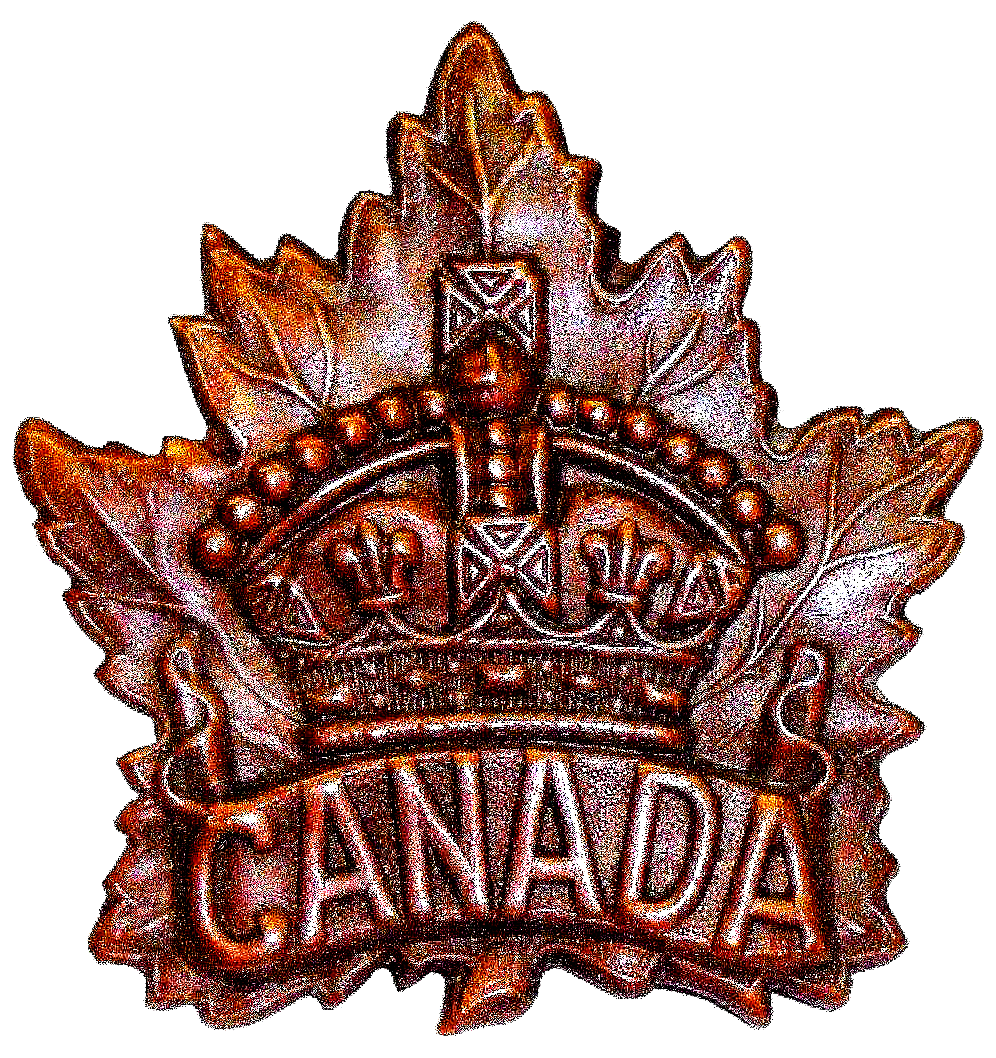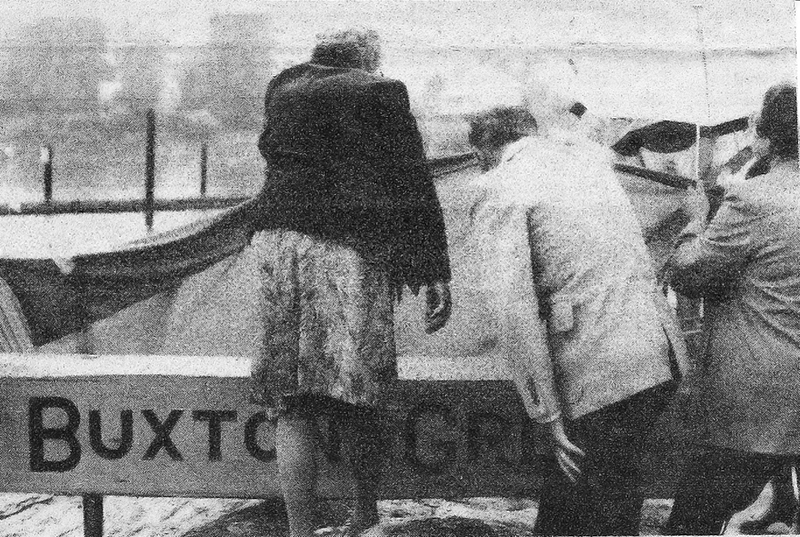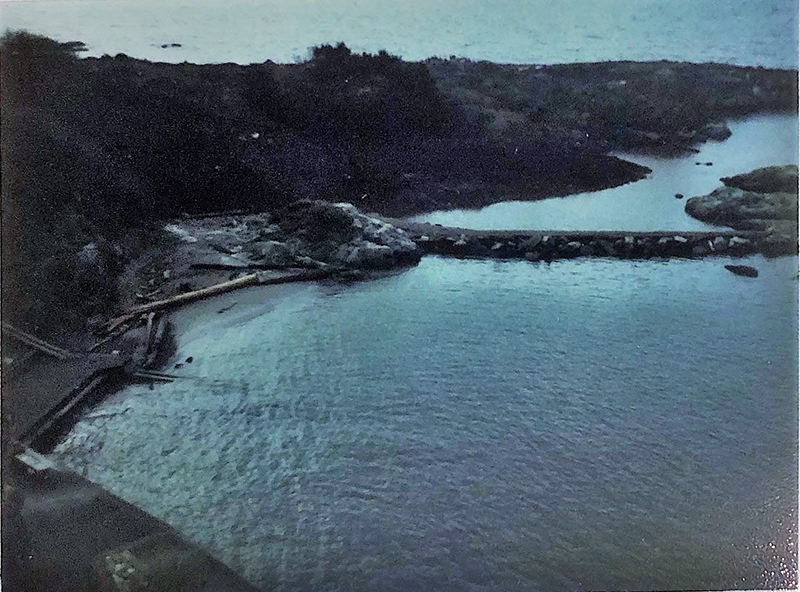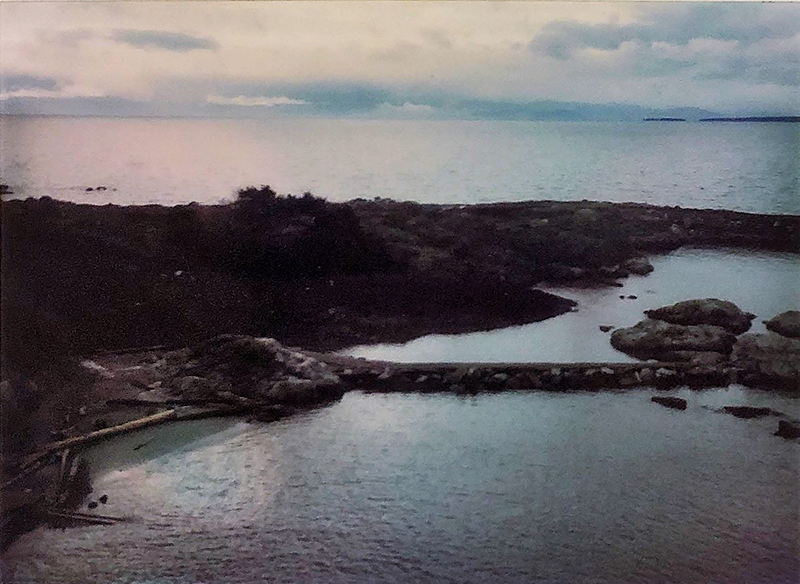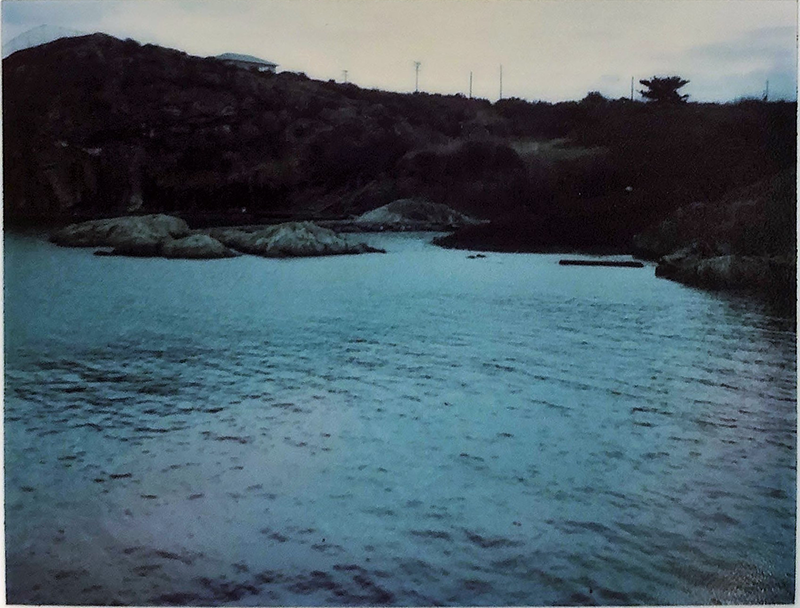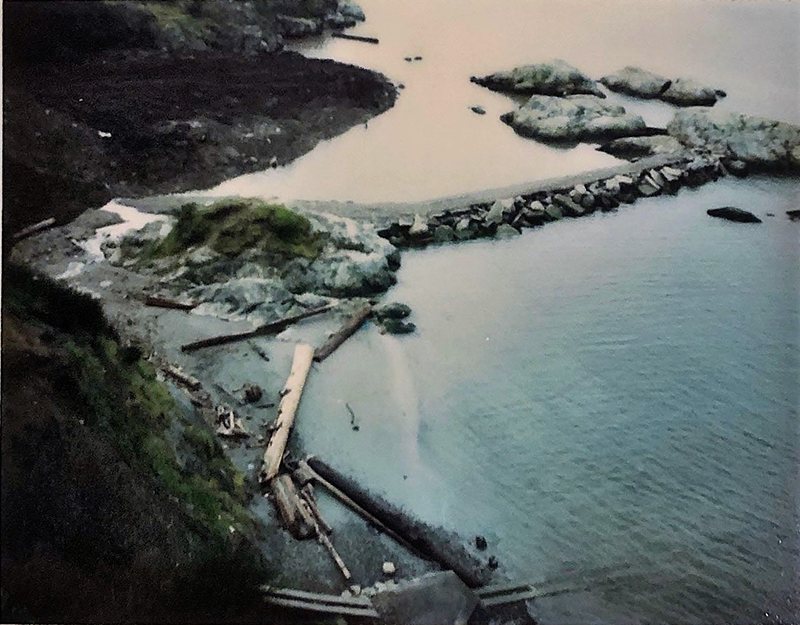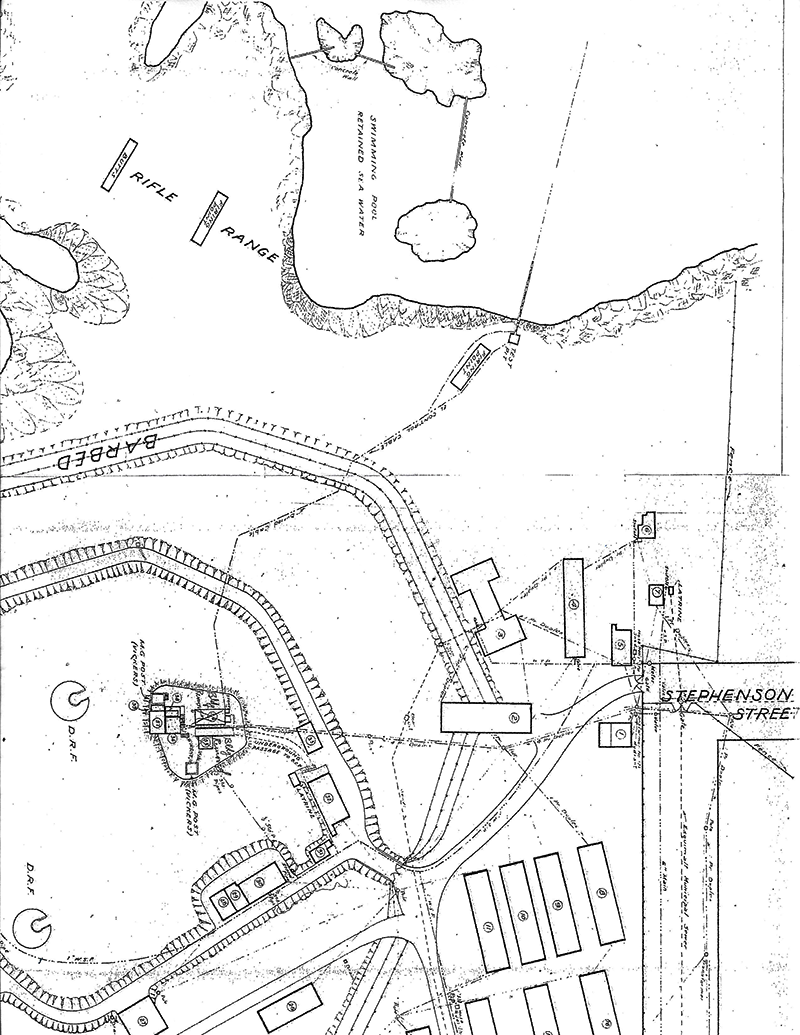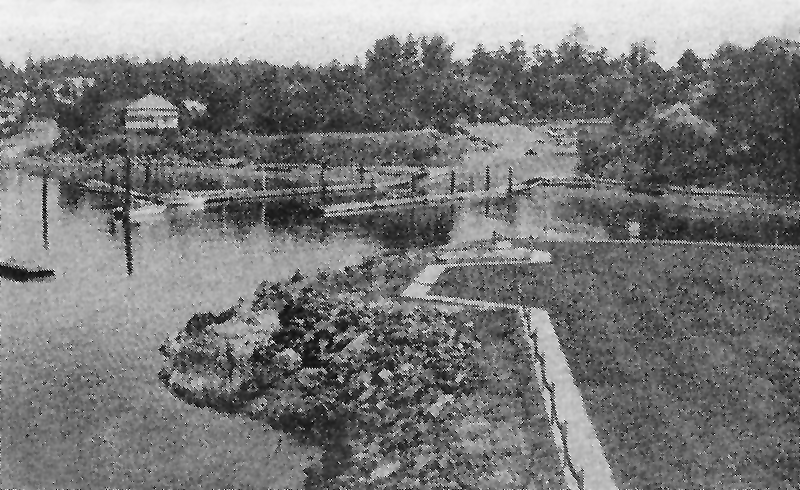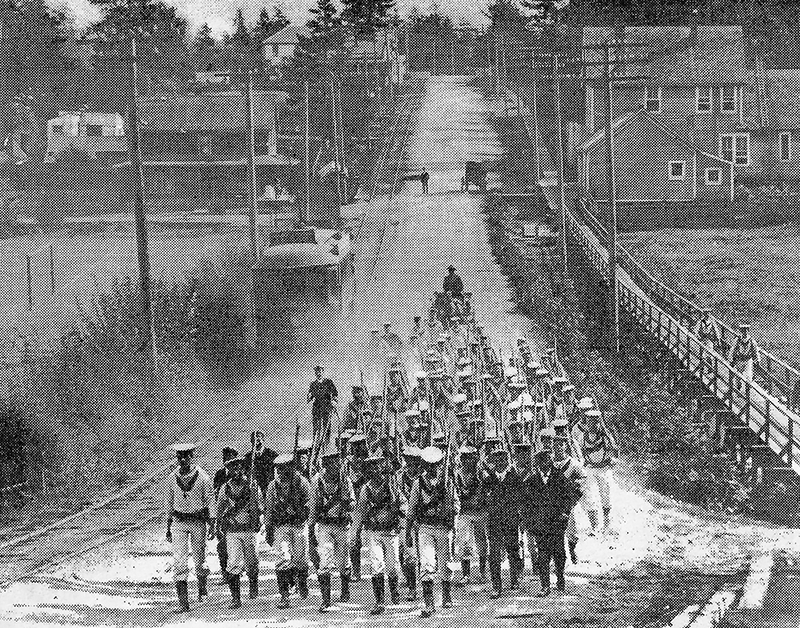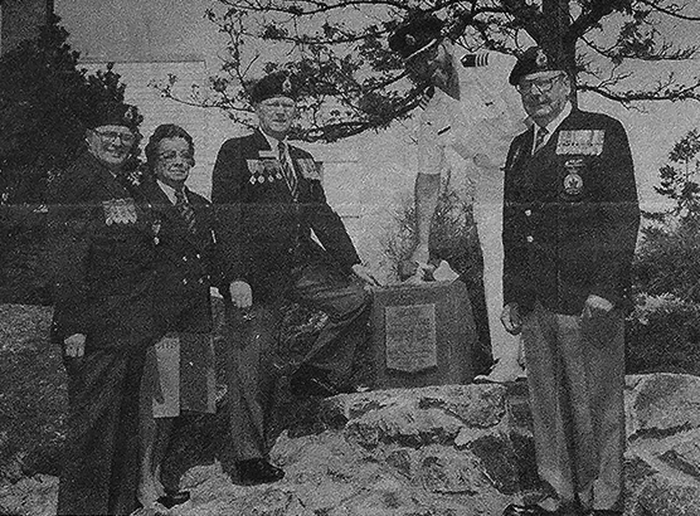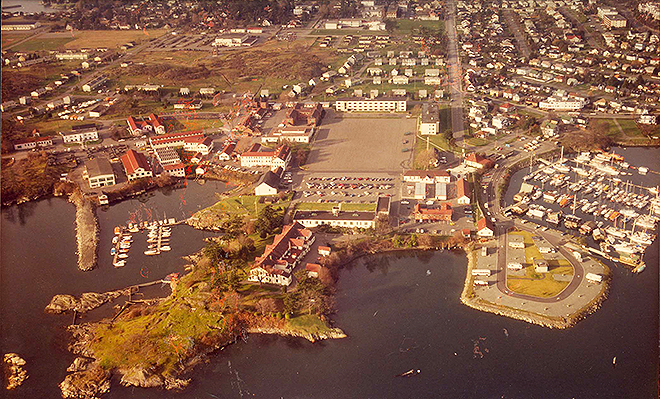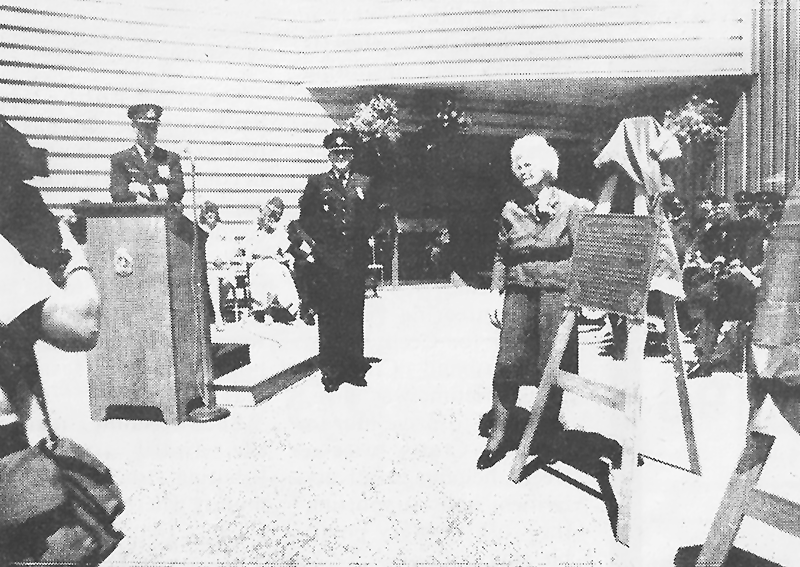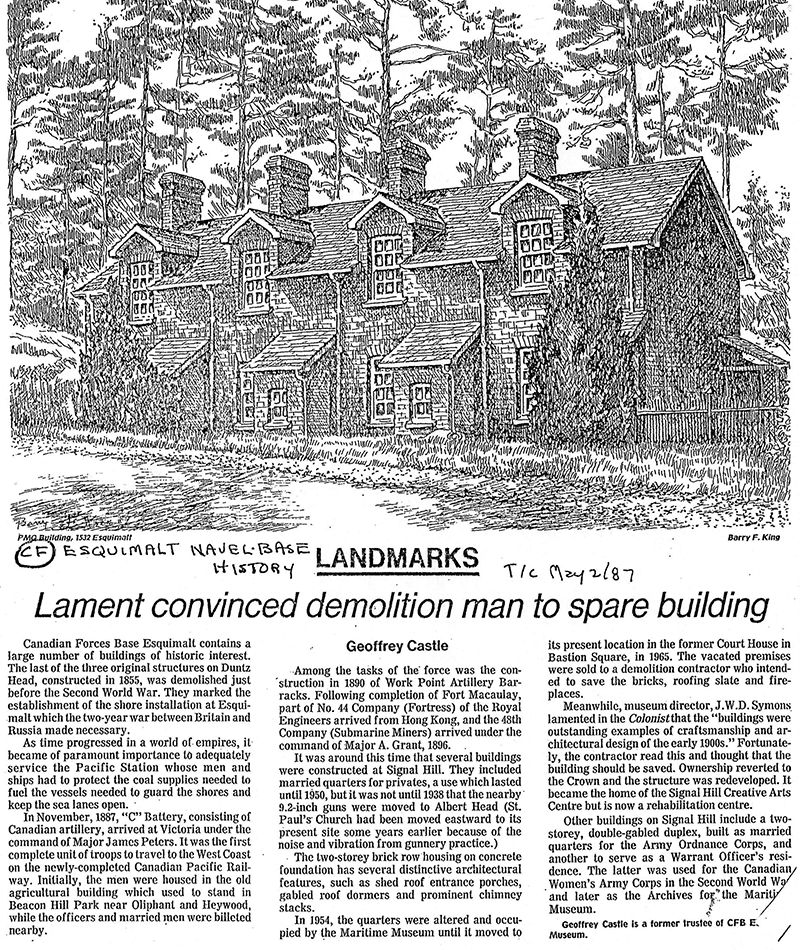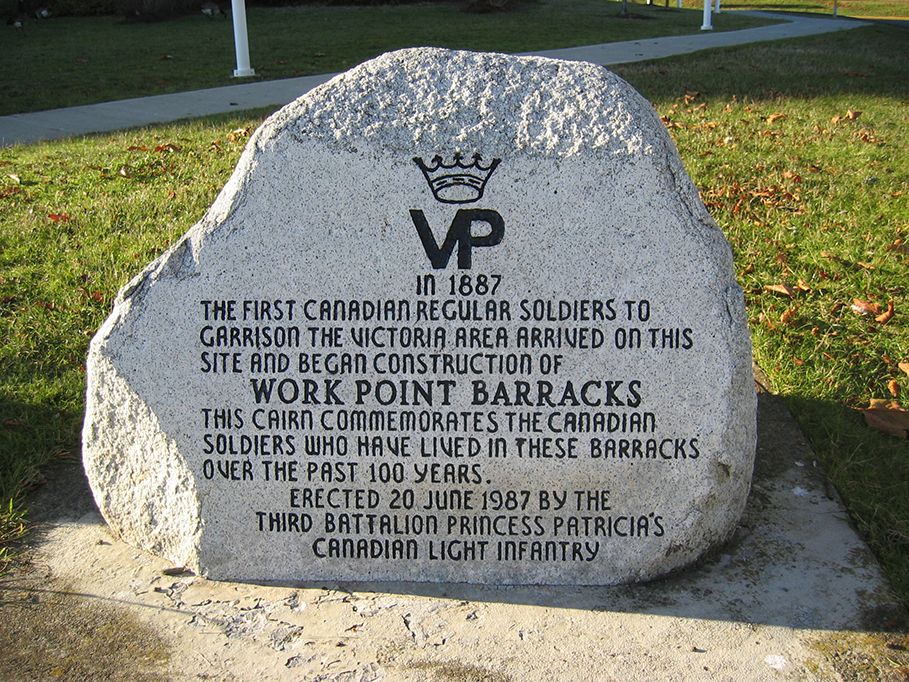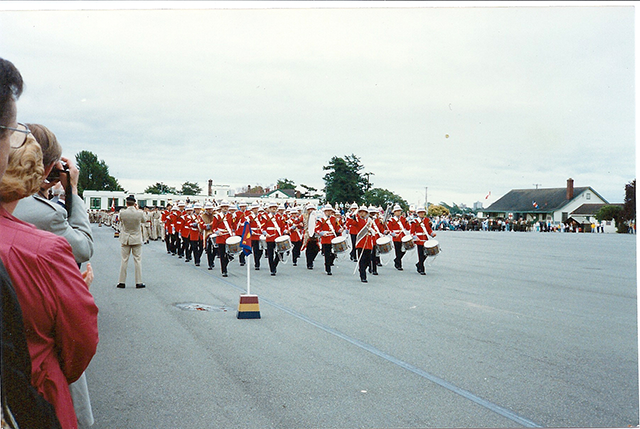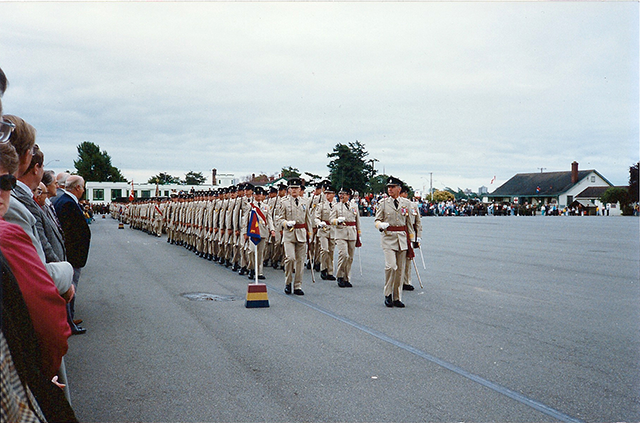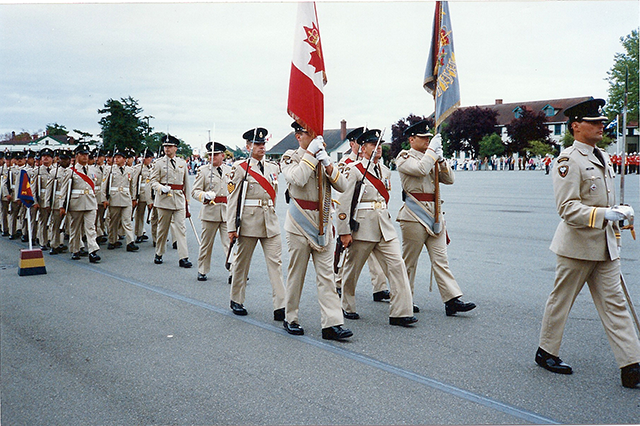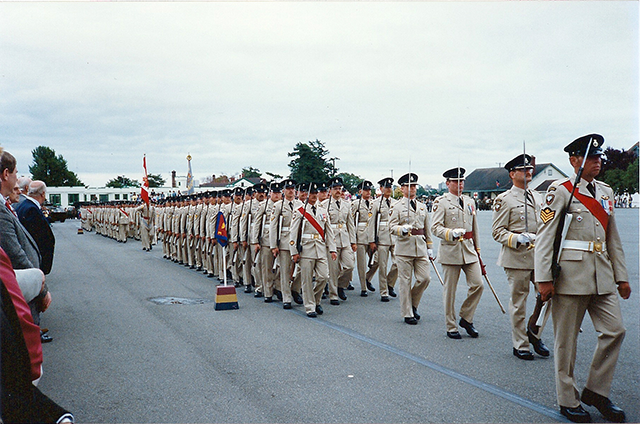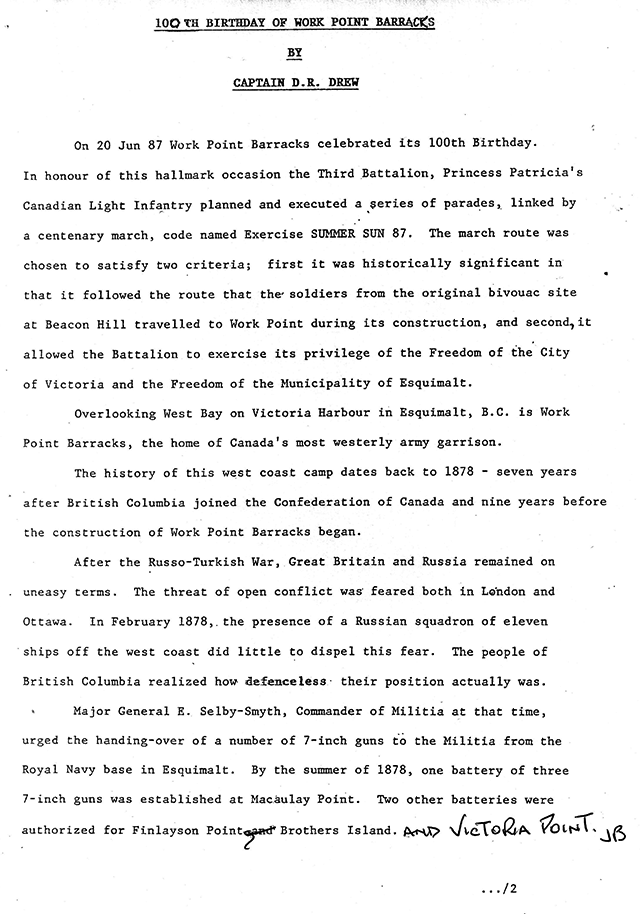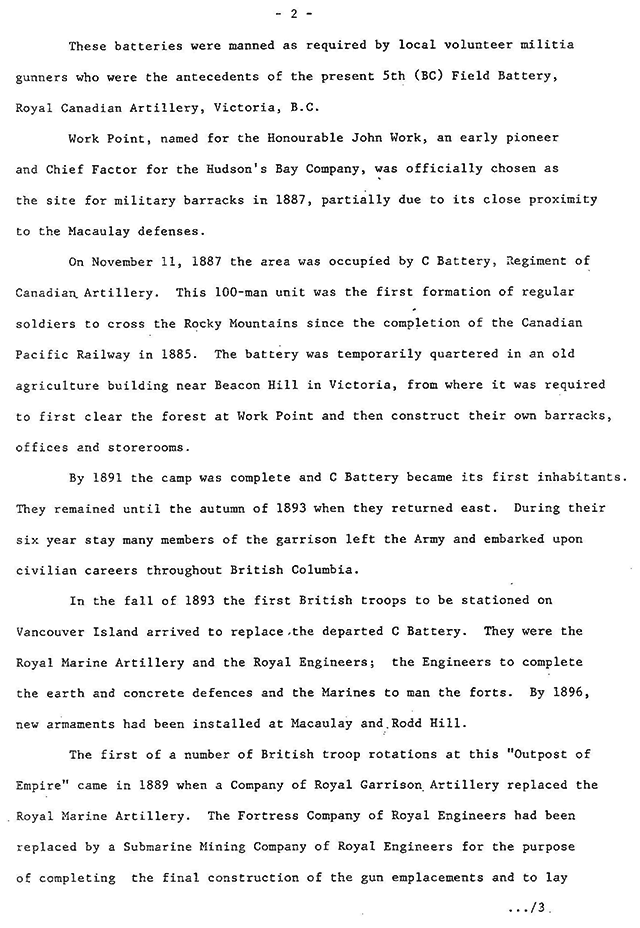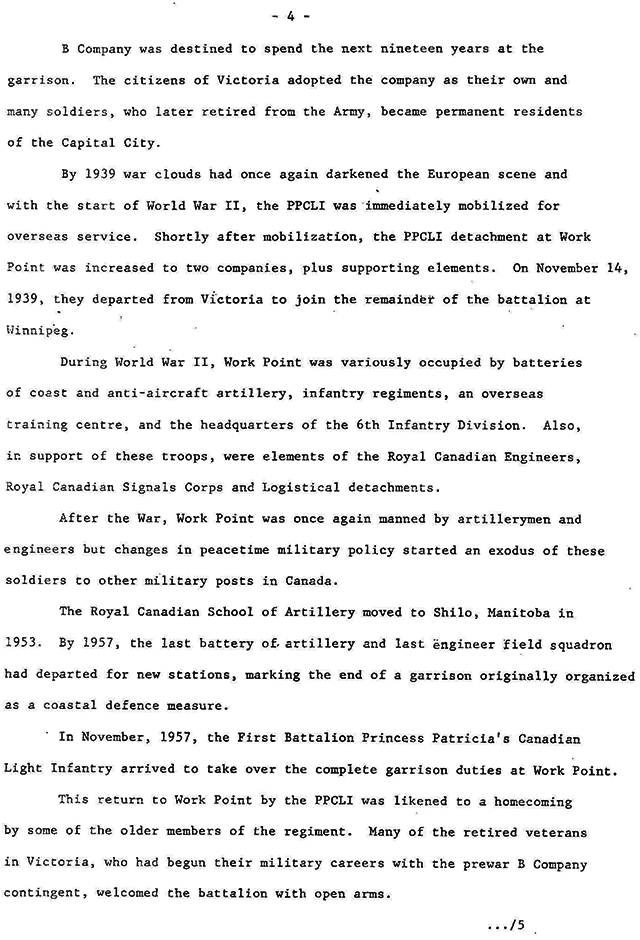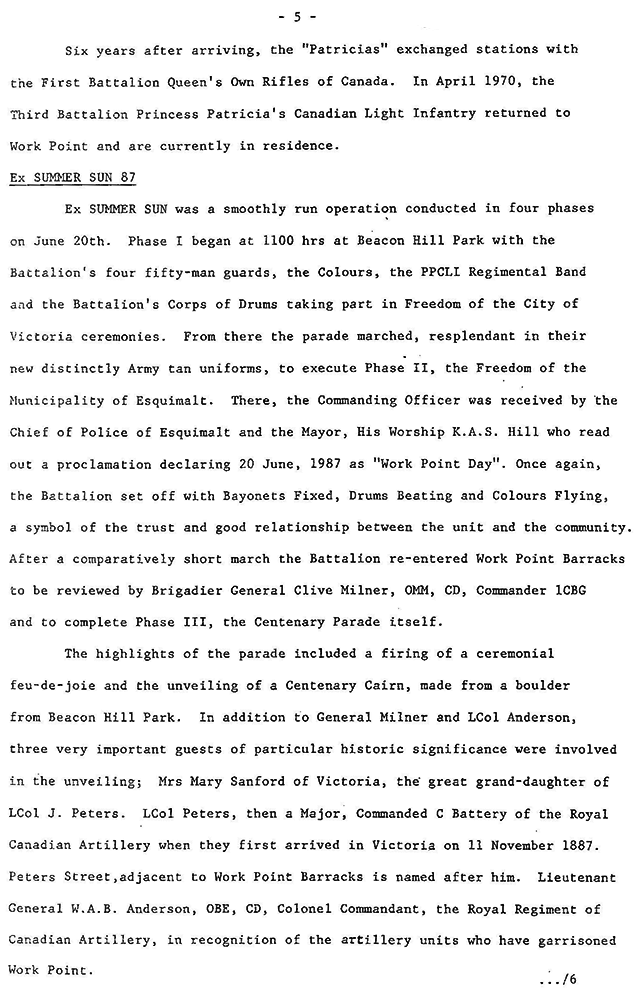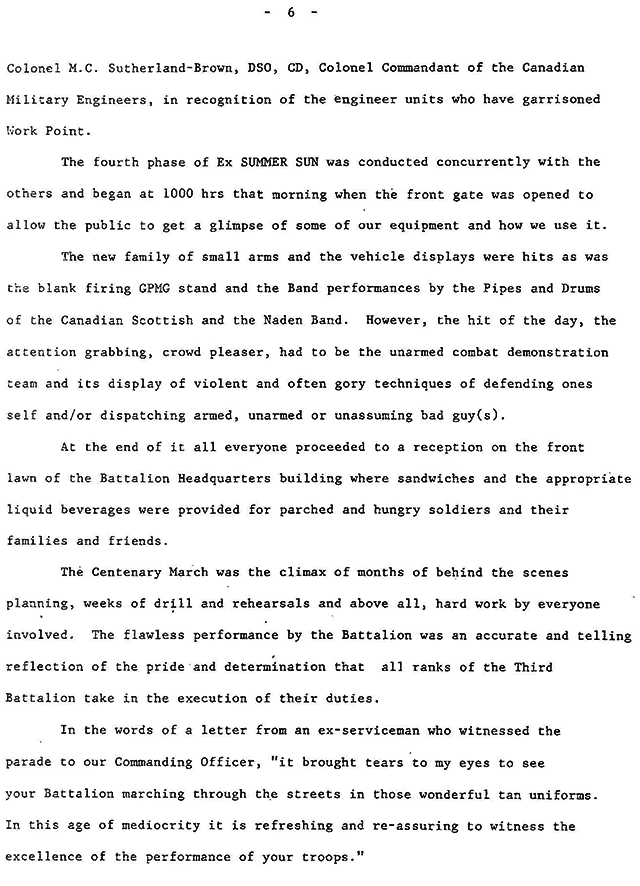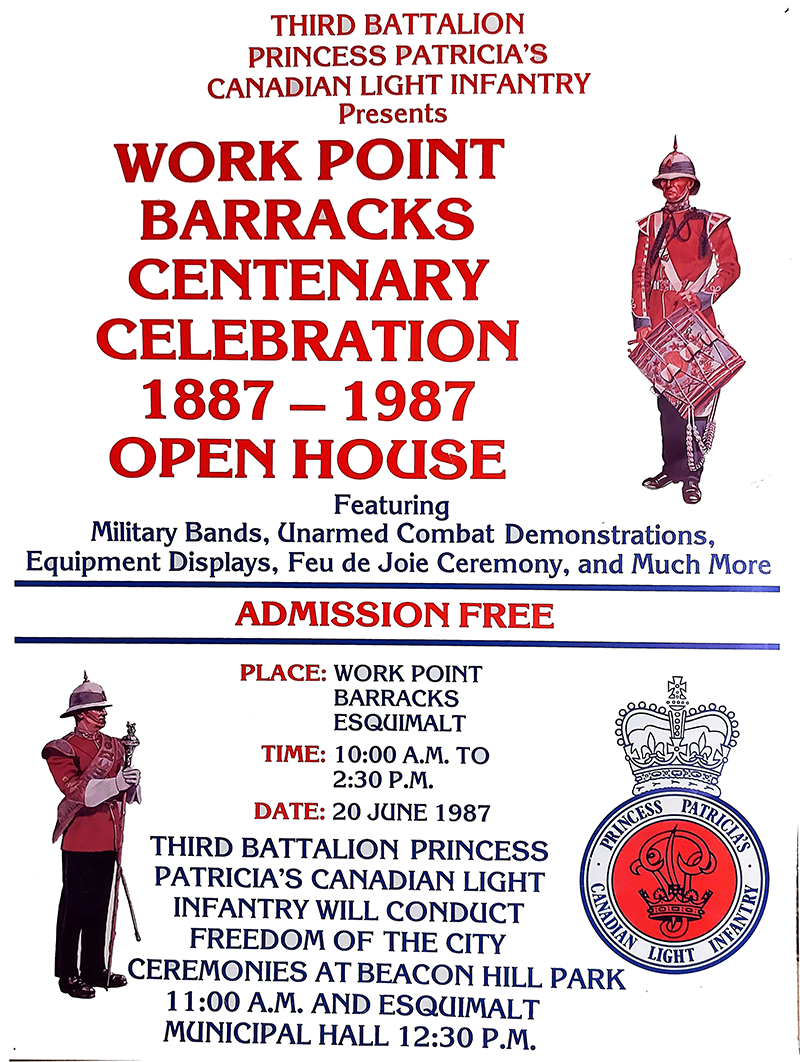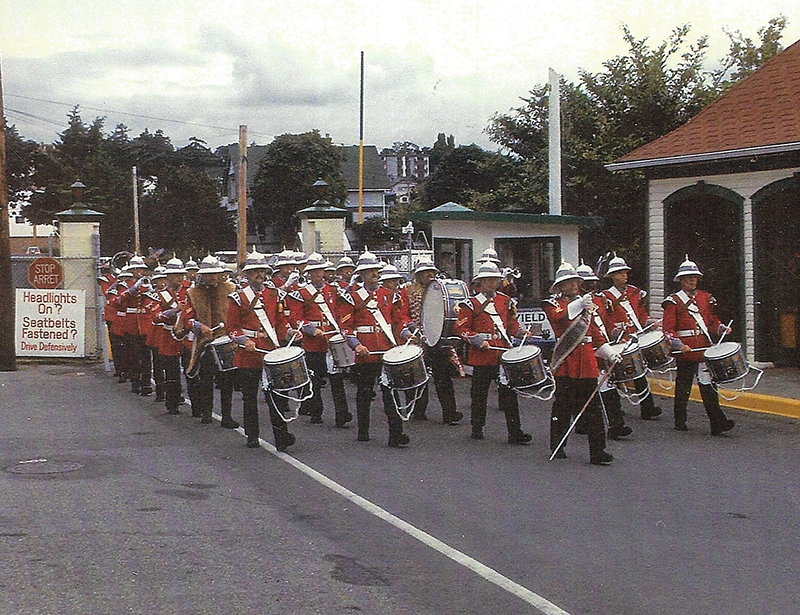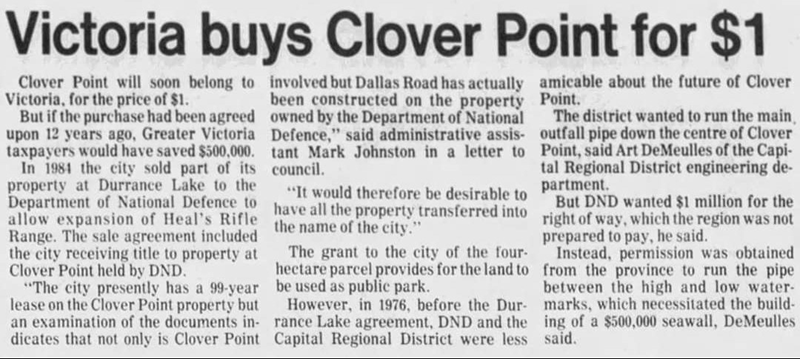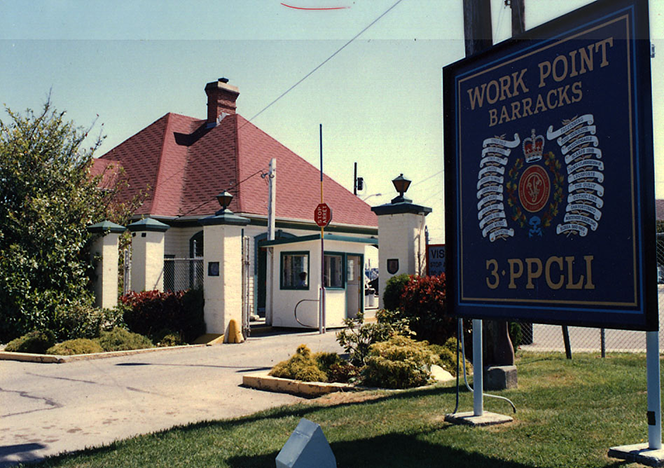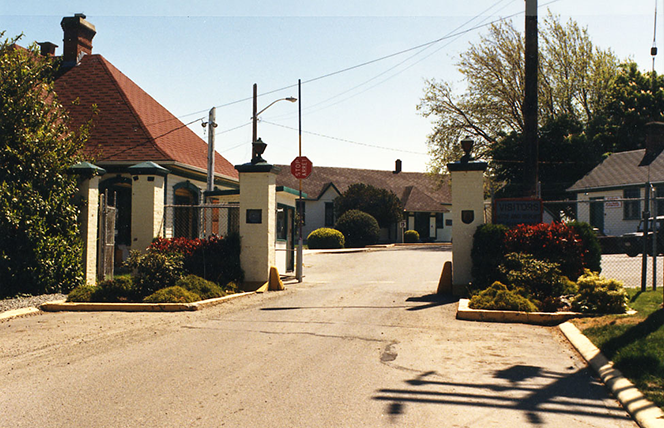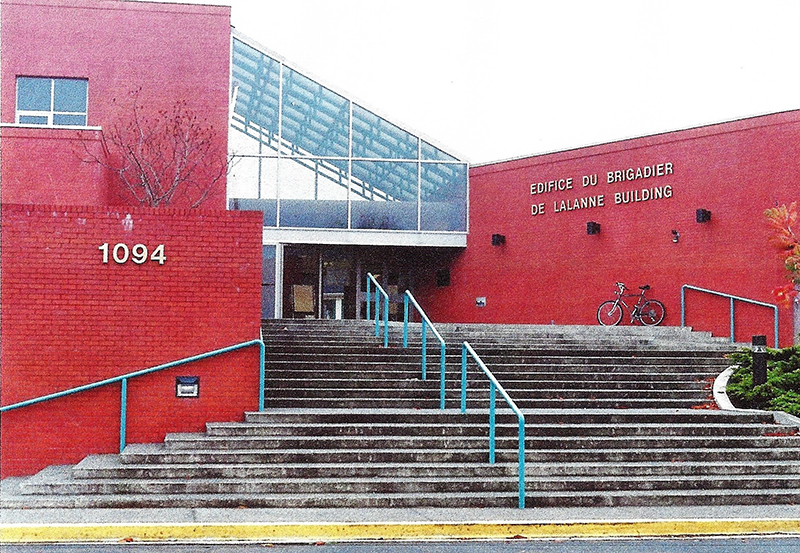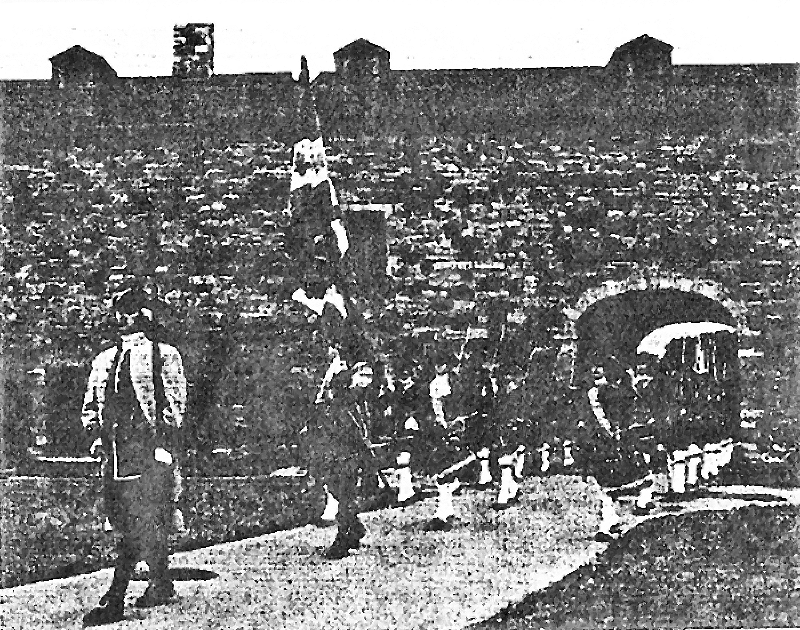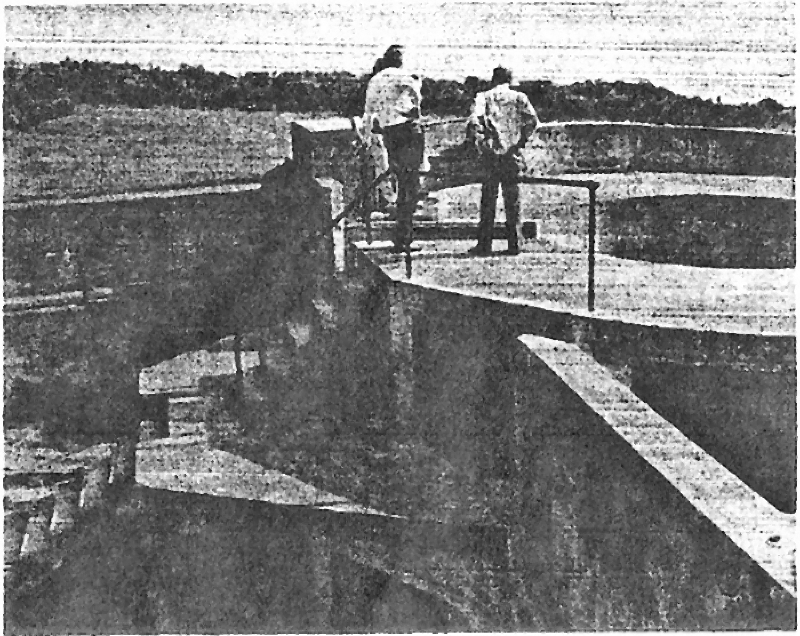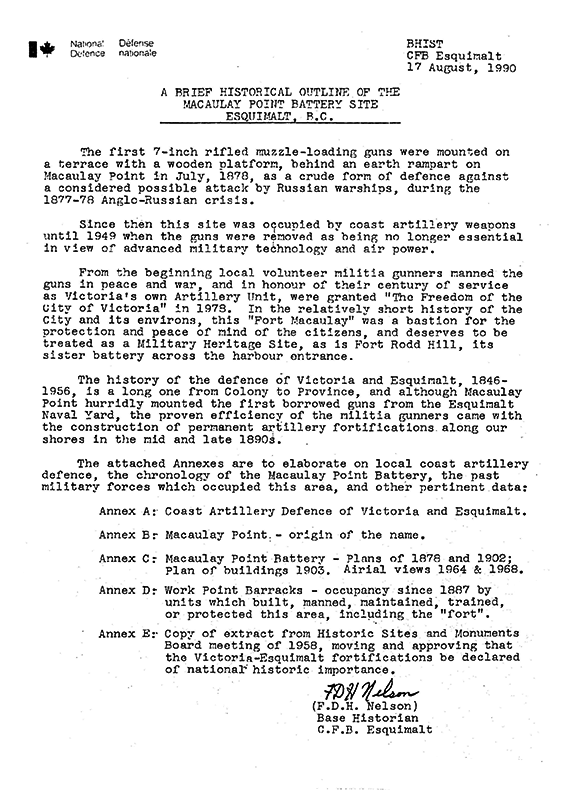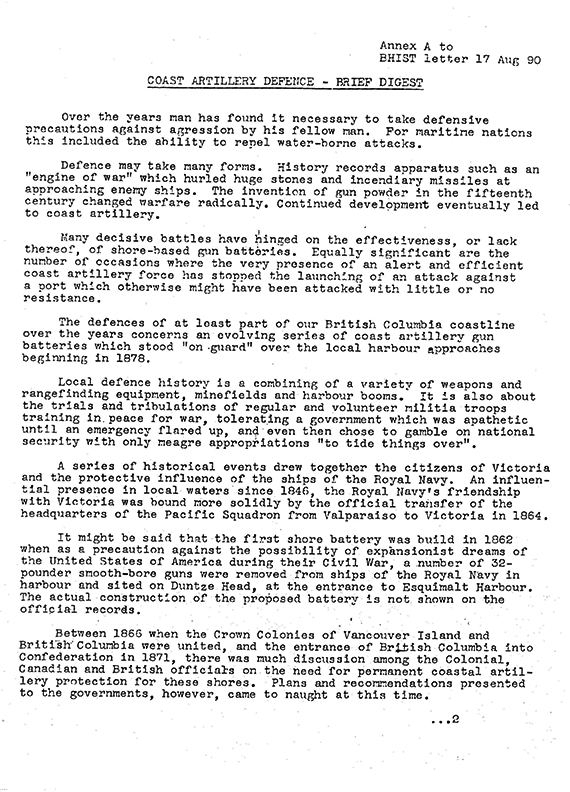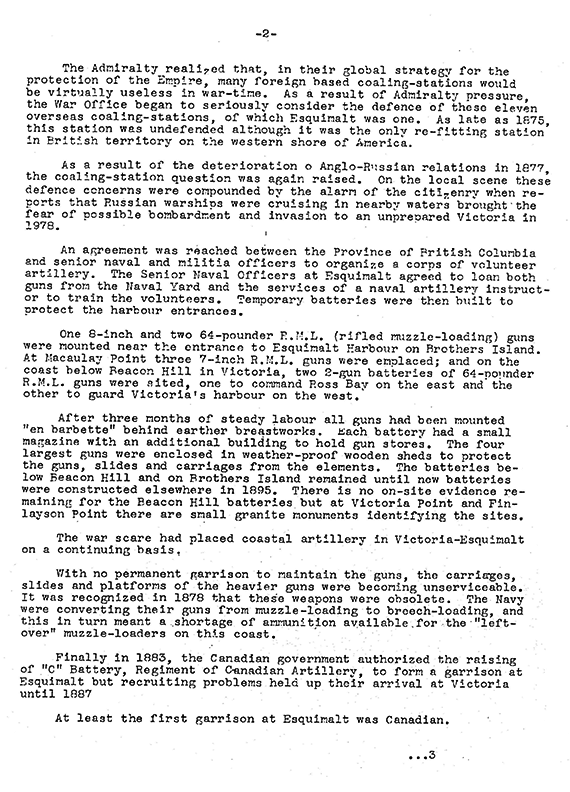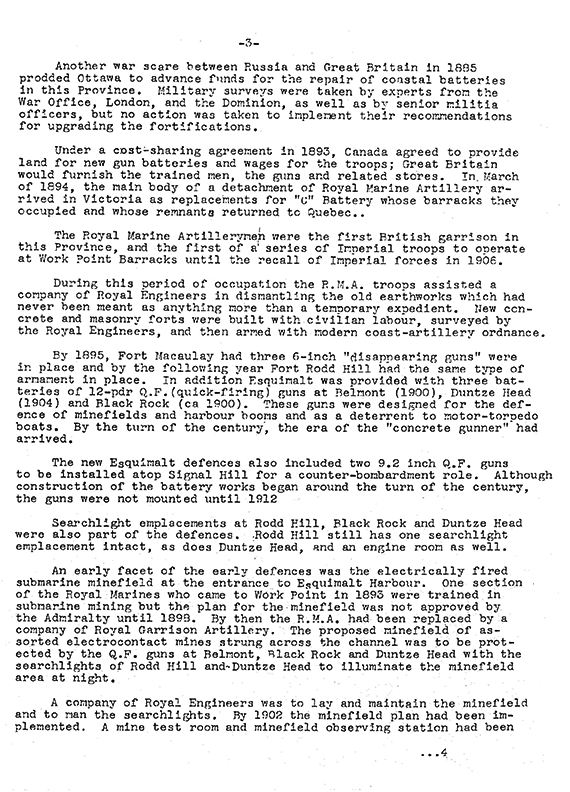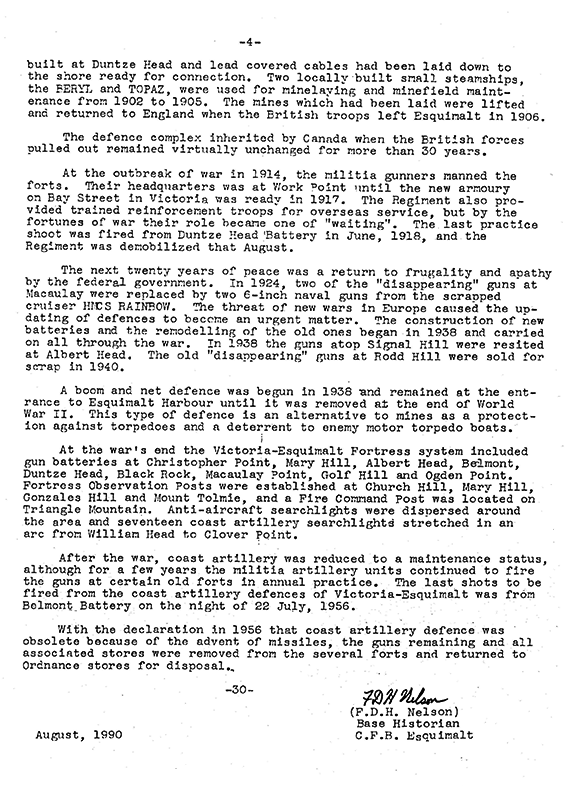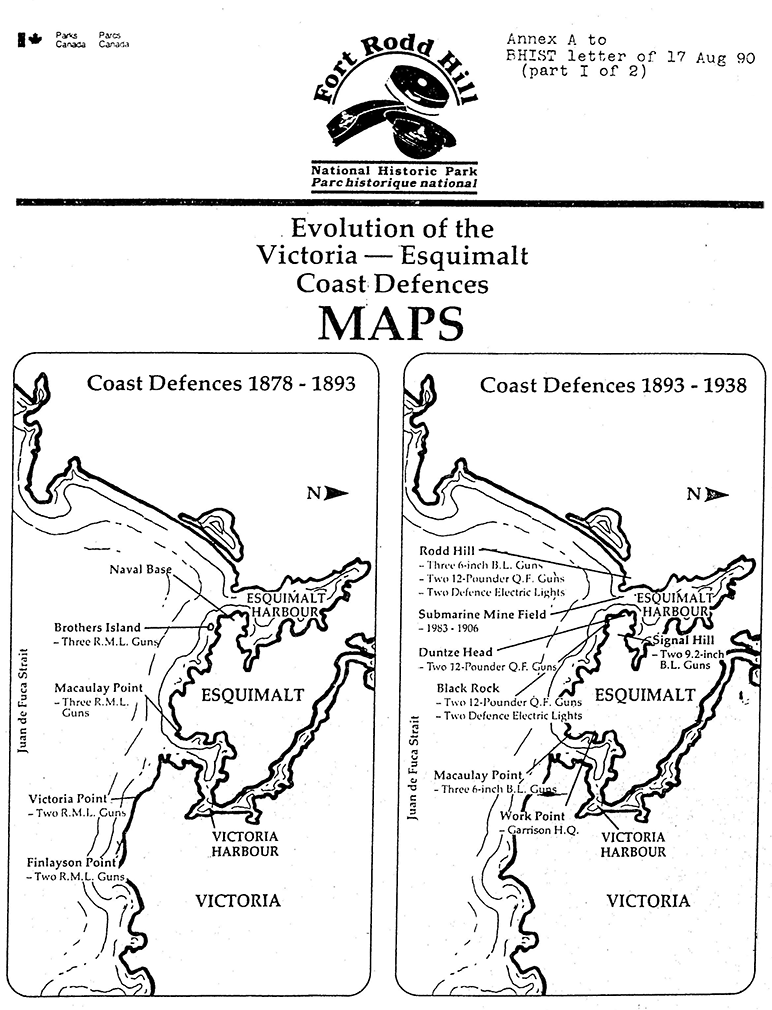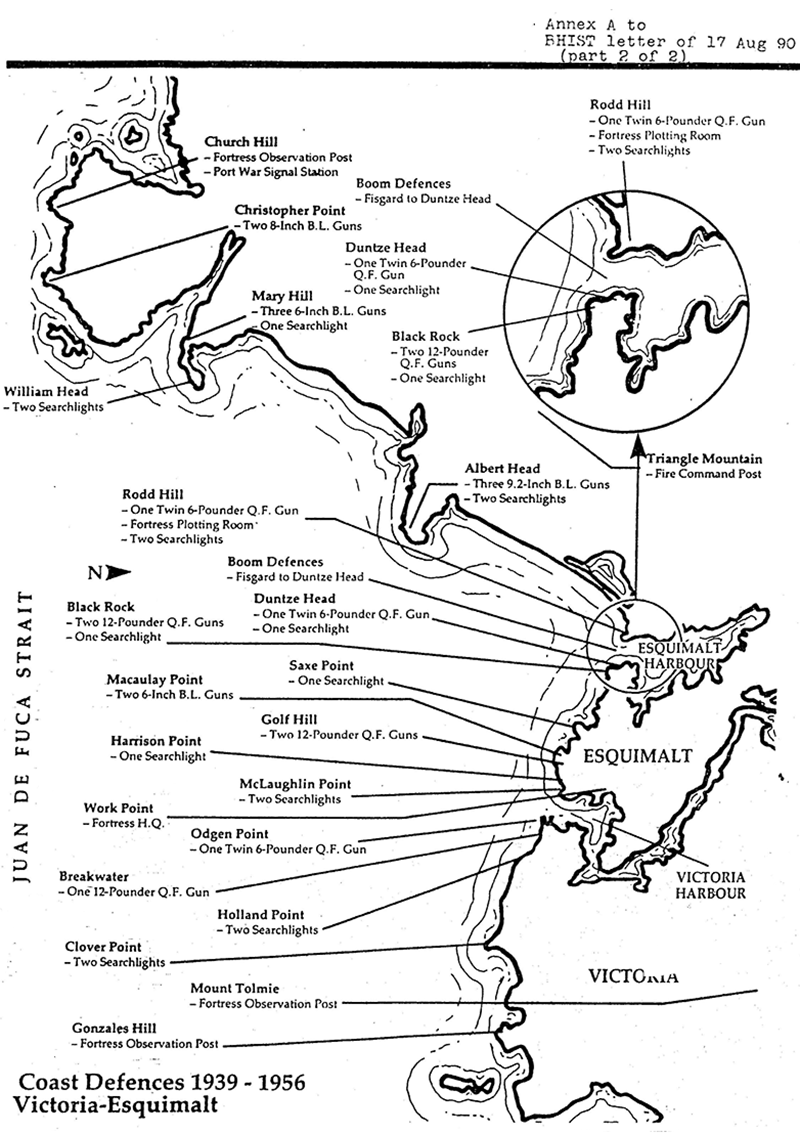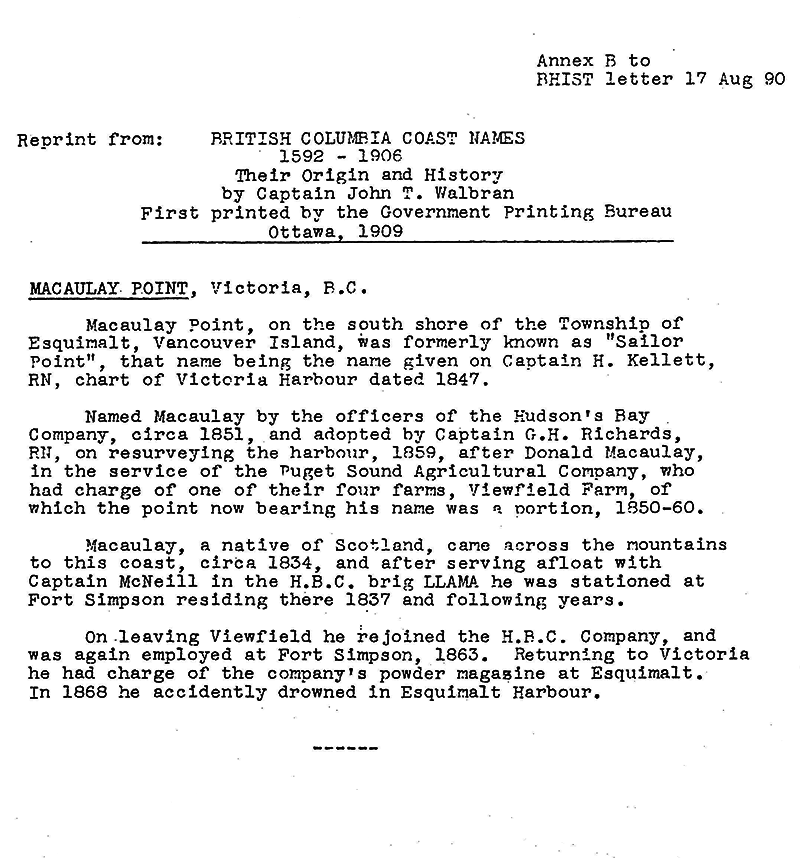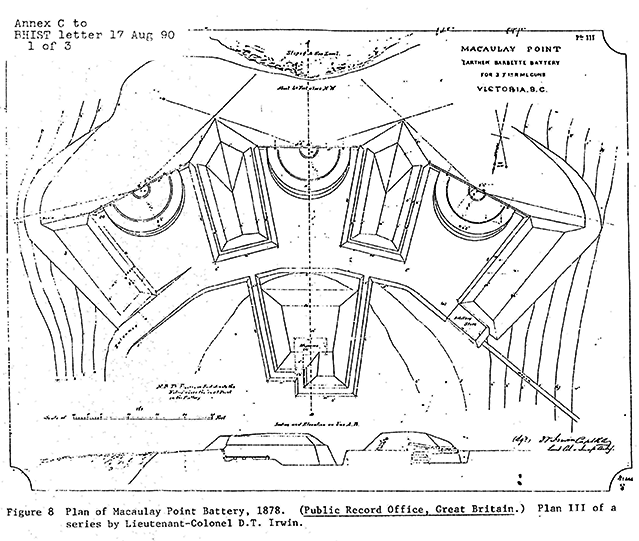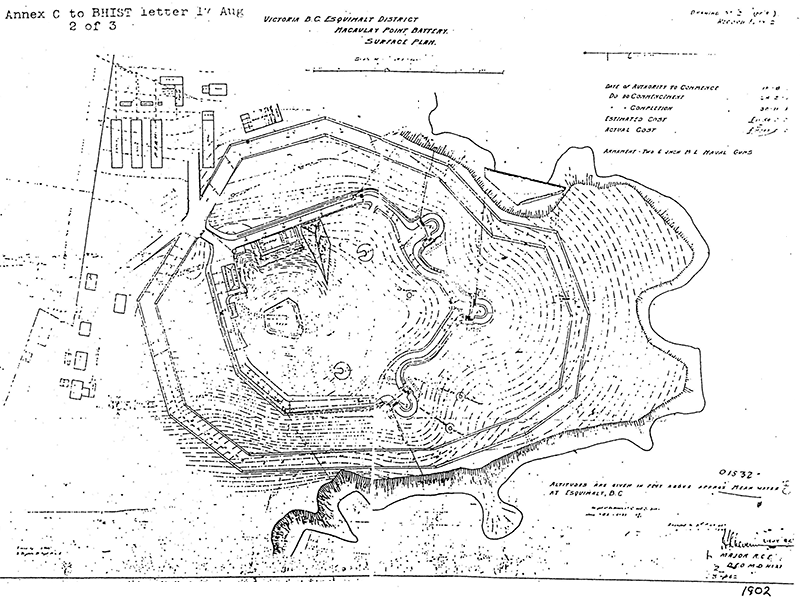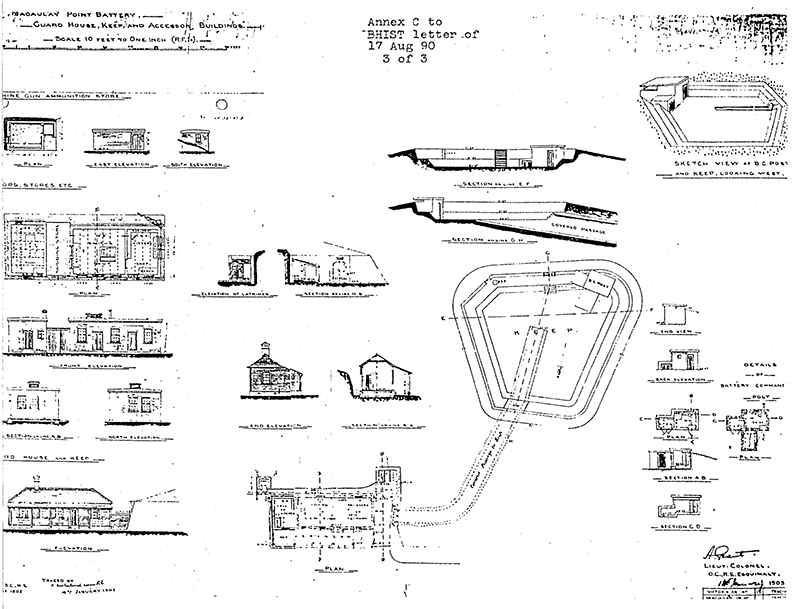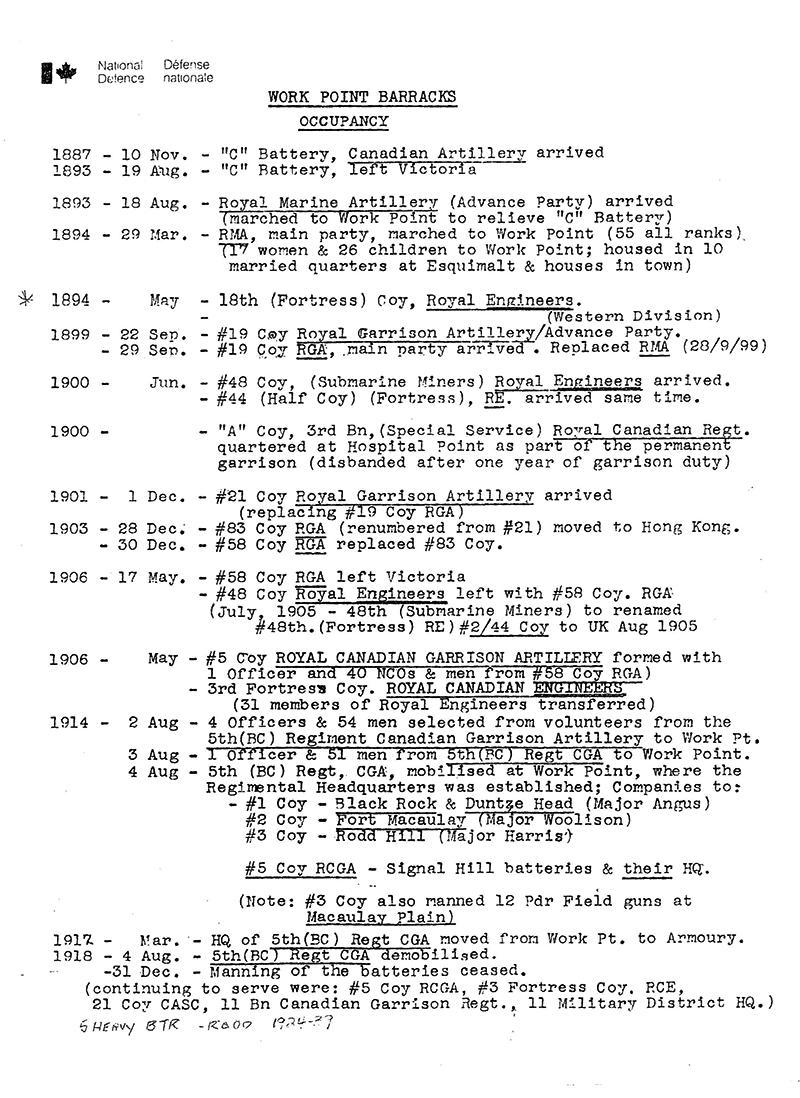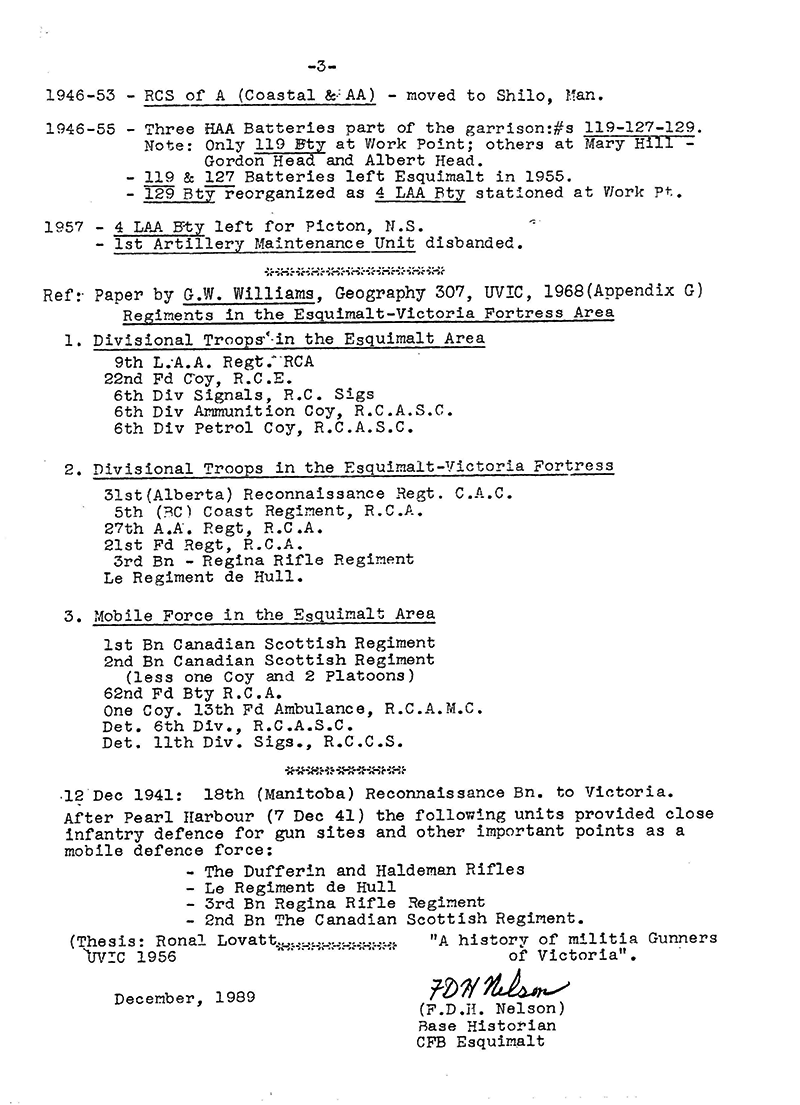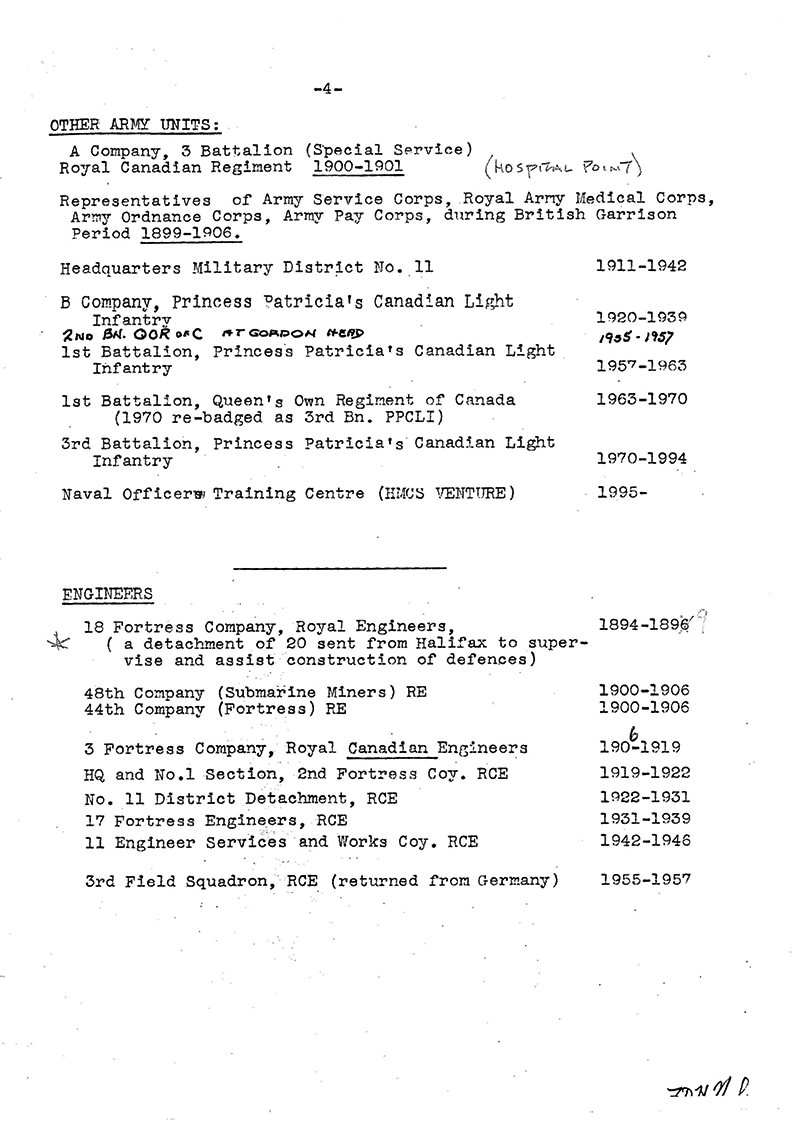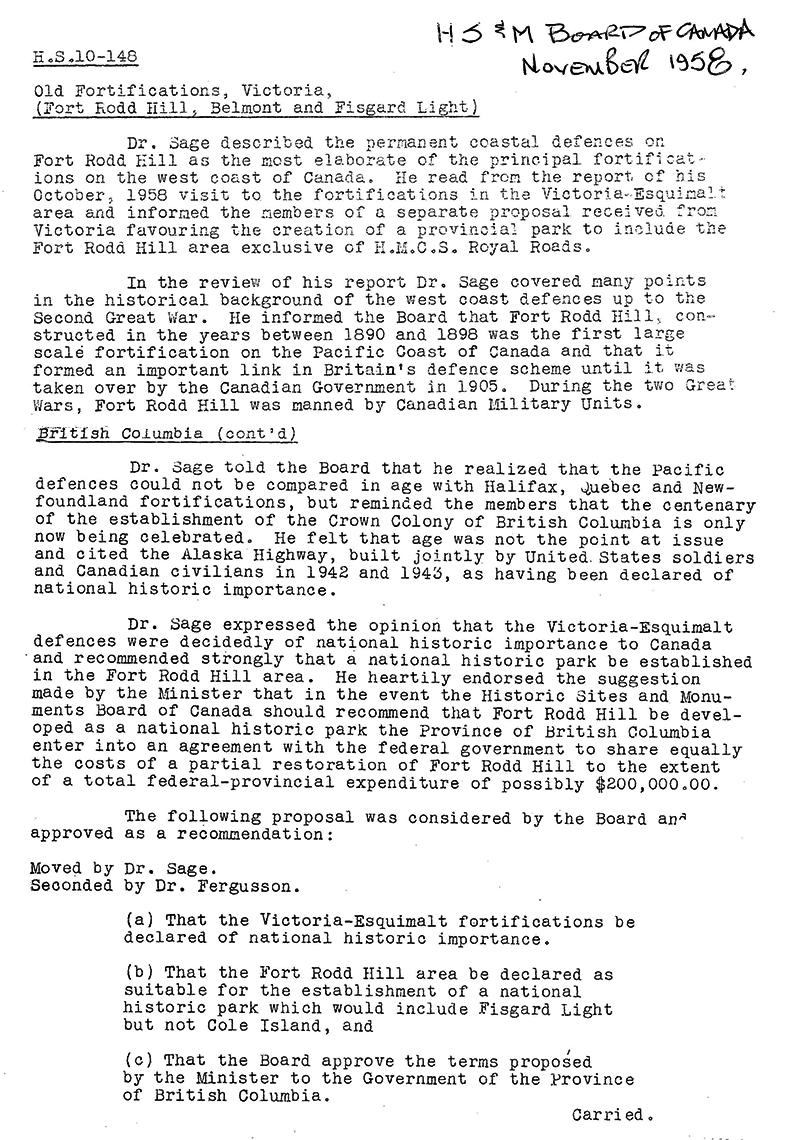 |
 OPCMHVisitor No.: |
HISTORY OF WORK POINT BARRACKSby Jack BatesPART 9 — 1971 to 199419833PPCLI TROOPING THE COLOUR THIRD BATTALION PRINCESS PATRICIA’S CANADIAN LIGHT INFANTRY Royal Athletic Park Victoria, B.C. Friday 1 July, 1983 ESQUIMALT STAR A YEAR IN THE LIFE OF THE PROVINCIAL POLICE Thursday June 23, 1864 Mr. Wilby reported that he had been out to McAuley’s Point in the afternoon and had seen the body of several head of cattle which he believes to have been shot. He also saw a colt with a broken leg caused by a shot wound. The colt was still alive. Friday June 24, 1864 On duty in search of the cattle reported by Mr. Wilby to have been shot at McAuley’s Point. Friday July 15, 1864 At 9 a.m. Mr. Colley reported to me that an Indian woman had been murdered near the naval hospital. I immediately went over to the spot indicated, but the body had been removed by the Indians. I found the body at the Indian Village. The deceased is a woman belonging to the Saanich tribe, she is about 24 years of age. I saw marks of violence about her head as if inflicted by a blunt instrument which I have no doubt caused her death. At the spot where the body of the deceased was found the ground was turned up and the fern broke down as if a great struggle had taken place. I also found some pieces of rock covered with blood which had been the instrument used to cause the death of the woman. The Indians are under the impression that it was some northern Indians who done the deed. Monday August 1, 1864 Sgt. Blake started to Victoria at 8 a.m. and went to McAuley’s Point on the way there he found the grass on the point on fire. Caused by the Indians light their camp fires very carelessly. I succeeded in putting out the fire and give the Indians a caution to be more careful for the future. These stories are from the Provincial Police files of the day, note the spelling of McAuley’s Point. The Esquimalt Star BUXTON GREEN PARK was officially dedicated recently under a tremendous downpour, (top pic) Mayor Ken Hill (far left) and Laurie Wallace, Vice Chairman of the Provincial Capital Commission look on as Evelyn Buxton and Doug Knight cut the ribbon (bottom pic) Mrs. Maude McKenzie (nee Buxton) helps unveil the sign. Among the 135 people who turned out for the dedication ceremony 90 per cent of the Buxton family was on hand. Many of the executive of the Esquimalt Anglers past and present were also on hand. The Anglers spent about $80,000 developing Buxton Green. Picnic tables donated by the Lion’s Club were also dedicated. The Buxton family has been a part of Esquimalt’s history since the early part of the century.
Opposite the Esquimalt Angler’s Association building there is a memorial rocked wall, dedicated to the many “anglers” who have launched their boats here, and returned “with or without” fish. In the 50’s, Kenny Buxton, with a lot of us friends, used to swim at Fleming Beach and catch the odd octopus in the salt water tidal pool, built in 1941 by the 60th Battery, RCA, filled in now as part of Buxton Green.
December 7, 1983 WORK POINT - "C" COMPANY ARRIVES Victoria Daily Times, May 12, 1906. Imperial Troops at Esquimalt. Canadian regular forces were first stationed in Victoria in 1887 when C Battery CA was formed for garrison duty in this province. It consisted of 18 NCO’s and men half from A Battery at Kingston and the balance from B Battery at Quebec. The arrival on November 17th of the new troops was marked with great enthusiasm. No barracks had been fitted for the reception so they were accommodated in the old Agricultural Hall at Beacon Hill, which remained home for 3 years until suitable quarters had been built at Work Point. Their only service outside garrison duty, was in 1889 when they were sent to Skeena River to quell an Indian disturbance which was done without bloodshed. “C” Battery left this province in 1893. Esquimalt had become a place of great military importance. This caused the Colonial Defence Committee to enter into negotiations for its better protection and, as early as 1889 steps were taken in this direction. In that year a small party under the command of Lieutenant J.J. Lang, R.E., was dispatched for the purpose of making a preliminary survey of the land in the vicinity of the city and the naval headquarters. This occupied some 2 ½ years. The completion of this survey put matters further in train and in 1893 an agreement between the Imperial and the Dominion governments was arrived at whereby defence works, costing about $300,000 were to be constructed at joint expense. The Dominion agreed to pay the entire cost of the Imperial Government and to hand over Work Point Barracks at a valuation to be deducted from the former’s share of costs of the fortifications. The Imperial Government, as its share, undertook the superintending of works, to provide armament and stores for submarine mining and half the cost of the defence works. In pursuance of this agreement, on August 4th, 1893, Lieutenants Templar and Barnes RMA arrived with a small force to take over the barracks at Work Point and “C” Battery left the next night for Quebec. The officer selected by the War Office, Major H.H. Muirhead R.E. reached Esquimalt from England a few days later and a decision was reached to construct the works by day labour under sapper supervision. A further detachment of the 18th Co. R.E. arrived on 1st of May 1894 and work was almost immediately commenced on the battery at Macaulay Point. A large number of civilian labourers were employed and the different works decided upon were taken up and completed early in 1896. Submarine mining at Esquimalt dates from 1897. The above version was condensed and written by F. Longstaff, the full version, with photos, is in the Times, May 12, 1906. Parks Canada A History of the Defence of Victoria and Esquimalt: Royal Garrison Artillery Period 1899 – 1906. As the previous two writings by Ron Lovatt, and as we get closer to family histories, this 238 page booklet is another most interesting read with the variety of content and illustrations. Parks Canada A History of the Defence of Victoria and Esquimalt 1918 – 1956. This 164 page booklet is the 5th (not sure about the # 4) and last of the histories by Ron, covers a time frame as above with some prior year’s content, and includes illustrations. This is more current and again well worth a view. It coincides with Fort Rodd Hill as a National Park. 1984AB Tony Irons, HMCS Saskatchewan, RCN, spent 78 days, to September 25th, in the Work Point Barracks guardhouse pending trial for a mutinous act on July 10, 1984, the cells block in Naden being condemned at the time. Aside from his deeds of that day he was a tremendous artist. To his credit he designed a new NAVY RUM label for the 75th Canadian Naval Anniversary, for which he received a $200 award, but declined so the tale goes. DISCOVER ESQUIMALT BUXTON GREEN This delightful area, named after a pioneer family of Esquimalt, was initiated and developed by the Esquimalt Anglers’ Association. The Esquimalt Lions Club donated the picnic tables and the Provincial Capital Commission have provided funding to finish the walkway to Buxton Green, install lighting for the walkway and the park area, and also a water line for irrigation. Eventually, a walkway will rise up to a lookout point at the land end of the breakwater, to be totally accessible by the disabled members of the community.
EARLY HISTORY OF ESQUIMALT Don Manuel Quimper was credited with being the first European to visit Esquimalt in 1790 and tagged the harbour Puerto De Cordova. When James Douglas came in 1842 to choose either Camosack (Victoria) Is-Whoy-Malth (Esquimalt) or Sy-Yousung (Sooke) as a site for a Hudson’s Bay Company post, he reported to his superior Dr. John McLaughlin: “Is-Whoy-Malth is one of the best harbours on the coast, being perfectly safe and easy of access, but in other respects it contains no attraction” he was referring to a scarcity of fresh drinking water in the summer, and its unsuitability for farming due to the thick rock forrest terrain. He did buy much Esquimalt land for the Hudson’s Bay Company later when Fort Victoria was established. The Royal Navy was not interested in farming when it was looking for a permanent naval base on the west coast. However, with 600 acre Viewfield Farm being established during the 1850 in the Sayward area of Esquimalt, naval vessels began using Esquimalt Harbour regularly. In 1852 the sailors H.M.C.S. Thetis cut a road through the bush to Fort Victoria, that road is now known as Old Esquimalt Road. Constance Cove Farm was established in 1853 and took in part of what we now know as H.M.C.S. Naden. The manager’s residence was built on the slope above Skinner’s Cove which today is the Government Graving Dock. Craigflower and Colwood farms were established at this time around the north side of the harbour. All those farms were taken over by the Hudson’s Bay Company in 1858 and were either leased or subdivided. Some of the choicest land in Esquimalt was the Hudson’s Bay Company’s until 1934 when it reverted to the municipality for tax arrears. All the farm activity led to a resurvey of Esquimalt Harbour completed in 1858 by Captain George Richards of H.M.S Plumper. Survey teams of the Royal England (Engineers) set up a base near Skinner’s Cove in 1859 and did survey work until disbanded in 1863. Some stayed to settle in the area. During this time naval activity increased. Hospital facilities were completed at Duntze Head in 1855, seven acre naval reserve was set aside there in 1859. The hospital was transferred to the Royal England’s building, on a 10 acre reserve at Skinner’s Cove in 1862. In the mean-time homes were being built in the present dockyard area between the naval reserve and the foot of Signal Hill forming Old Esquimalt Village. The Royal Navy: Establishment was officially created on June 29, 1865 and the former headquarters of the Royal Navy Pacific Fleet was moved out of Valparaiso Harbour. An increase in the building of homes below Signal Hill as well as increased activity inside the reserve area.
Building activity surged ahead in earnest during the 1890’s. During this time red brick buildings and a brick boundary wall (a portion of which still stands behind HMCS Venture) were built. Also constructed were permanent residences and hospital facilities on the present site of HMCS Naden, and army quarters were built at Signal Hill and Work Point. July 20th, 1887 saw the opening of the present Naval Drydock with the docking of HMS Cormorant. The Royal Navy withdrew from Esquimalt in 1905, leaving three ships here under Canadian Government care for expenses and upkeep. The Royal Canadian Navy was formed in 1910 and took over the establishment, with HMCS Rainbow being the first RCN vessel to be stationed here. (Esquimalt Sentinel - June 23, 1965) 1985Parks Canada A History of the Defence of Victoria and Esquimalt, 1906 - 1918 This 181 page, part 4 of 5, covers the post Imperial forces departure time frame. Featured with illustrations are local personalities, camps and forts on the island such as Willows and strike duty in Nanaimo, along with the buildup to WW1 and eventually demobilization. PPCLI Regimental Memorials of Princess Patricia’s Canadian Light Infantry was published with a revised edition to coincide with the 75th celebration in 1989. This booklet contains local reference to Work Point Barracks, St. Paul’s church, Beacon Hill Park, Schjelderup Lake V.I., the Patricia Room at the Royal Jubilee Hospital and CPR liners. It also contains references to other memorials across the country and overseas as well as individual landmarks and memorials to notable persons of PPCLI history. I believe that the booklet should be updated and more photographs added to highlite the memorials. Of specific note at this moment would be the addition of the PPCLI cairn at Work Point placed June 8th, 2014 and a photo of the CWO RG Buxton memorial. Of course photographs should be added for all the individuals listed. ESQUIMALT NEWS LEGION PLAQUE UNVEILED A maple tree was planted in HMC Dockyard on V.E. Day 8 May, 1945 by members of the Royal Canadian Legion, Esquimalt Br. 172. On the occasion of the fortieth Anniversary of VE Day, in conjunction with the seventy-fifth Anniversary of the Canadian Maritime Force and the Diamond Jubilee of the Royal Canadian Legion, a new commemorative plaque was unveiled 8 May, 1985. Pictured (left to right) Cde Bill Stewart, Cde Jean McPherson, Cde Ernie Cassels, Cdr Bill Buckeridge A/BCMD, and Esquimalt Legion President, Cliff Ludke.
Esquimalt Archives 997.88-35 That the five year agreement between the Department of National Defence and the Corporation of the Township of Esquimalt for leave and licence to use the Department of National Defence land commonly known as “Macaulay Point” for recreational use and historic interest, be ACCEPTED; that the proper officials be instructed to prepare the necessary by-law to provide the authority to execute the said agreement; and that the amount of $200 required as payment for this agreement, be authorized paid. Esquimalt Esquimalt residents have a new five hectare park courtesy of the Department of National Defence. DND has given the municipality a five-year “leave and licence” permit to use Macaulay Point lands for recreation and historical purposes. The Esquimalt Anglers Association is currently cleaning up the parkland and making it more accessible for the public. Mayor Ken Hill has been working on the agreement for more than two years. The permit may be renewed after 1990. This letter was from the office of the Base Commander to Mayor Ken Hill. “Sir, it only took a short time after the right approach was taken.” Signed Larry. A HISTORY OF THE DEFENCE OF MANNING THE DEFENCES JULY 25 – AUGUST 5, 1914 These pages cover the report by Ron Lovatt of Parks Canada on CC 1 and CC 2, the submarines purchased by the BC Government on August 5, 1914, prior to the declaration of war against Germany. Click to view as a PDF. 1986
A new BC Land Registry plan numbered 41833 was registered on September 2, 1986, which consolidated the plans in Work Point Barracks and Macaulay Point exclusive of 1870R, CRD property; and 35322, the former Imperial Oil property on Victoria View Rd. The lands were previously shown on plan 195A, Viewfield Farm. ESQUIMALT STAR HOOD BUILDING OPENED ESQUIMALT – Mrs. F.B. Hood officially opened the new Canadian Forces Base Esquimalt Construction Engineering facility Friday May 30, 1986 at 1:45 p.m. The new facility named the “Hood” building, is in honour of the late Colonel, the Honourable Francais G. Hood. Colonel Hood served with distinction at Esquimalt with the Royal Engineers 48 Submarine Mining Company from 1902 to 1906. The present building is located on the original Royal Engineers 48 Submarine Mining Company site. Mrs. F.B. Hood is the wife of the son of Colonel Hood. The $4.6 million contract for the Hood Building was awarded to Farmer Construction Ltd. Of Victoria. The new facility permits the consolidation of personnel and services of the construction engineering department that were previously scattered throughout the Dockyard in 14 separate buildings. The opening and dedication ceremony were attended by various serving and retired military and civilian officials. Members of the Royal Canadian Legion Branch 172 formed the colour party. The eulogy for Colonel Hood was delivered by the Commandant Canadian Military Engineering Branch, Colonel M.C. Sutherland-Brown. Mrs. W. Crow, wife of Mr. W.M. Crow, deceased, a C.E. employee for many years, presented a water colour painting to be hung in the new building. Also in attendance was Mr. and Mrs. F.A. Hood, grandson of the late Colonel Hood. It is interesting to note that Mr. Hood was born 80 years ago in a house which then stood where the Signal Hill parking lot is now situated.
Directorate of History This is a preliminary narrative and should not be regarded as authoritative. It has not been checked for accuracy in all respects, and its interpretations are not necessarily those of the Historical Section as a whole. THE ANTI-AIRCRAFT DEFENCES OF THE PACIFIC COAST
This information is available for research purposes. DHH FIXED COAST ARTILLERY DEFENCES ON THE PACIFIC COAST Click here to view a large PDF version of this report. ESQUIMALT STAR CLIMBERS FEAR BAN Local rock climbers are greatly concerned that Esquimalt Municipality may ban climbing on the rock face at Fleming Beach as it could set a precedent for bans in other jurisdictions. Greg Foweracher of Alpine Equipment spoke for a half dozen climbers who appeared at Monday night’s committee of Council to express their concern over a possible ban. A letter from Parks and Recreation Manager Jack Boutilier says the Municipal Solicitor recommends that a bylaw be prepared that bans all climbers, military and civilians, from climbing the rock. The military often use the rock face for training but the existing agreement between the DND and the Municipality does not give military personnel access to the park other than for any operational emergency. Foweracher said that he and most rock climbers would sign complete waivers to absolve the Municipality of liability if they fell while climbing. “Most climbers are responsible adults, and they know rock climbing is a dangerous sport. They are aware of the risks and take responsibility for it.” Fowerarcher quoted statistics that accident rate for climbers since the 1930’s has been .008 per 100 per year. The question of climbing on the rocks arose when loose rock falling from the cliff became a safety problem. Acting director of Engineering Services Norm Pugh said that a 50-75 lb. rock fell from the cliff putting a hole in the asphalt. Council referred the matter to the Municipal Engineer for a further report. ESQUIMALT STAR COLONEL HOOD REMEMBERED AS ATHLETE, MARKSMAN AND FISHERMAN The new Dockyard Engineering building was named after Col. Hood. Colonel Hood was born I 1880, the fourth son of Francis, Viscount Hood. He attended Chaltenham School prior to entering the Royal Engineers at Woolwich where he specialized in submarine mining. After serving in Halifax, Nova Scotia at the turn of the century, Colonel Hood as a subaltern came to Esquimalt in 1902 with the 48th Submarine Mining Company of the Royal Engineers during an upswing in Imperial defence posture. This particularly dynamic officer did much during a comparatively short period to strengthen the seaward defence installation of Esquimalt and Victoria. The installation referred to consisted of a sophisticated electrically fired controlled defensive minefield and association sights, carbon arc searchlights and quick firing guns. Himself a member of a most distinguished naval and military family, Colonel Hood in 1904 married Helen “Nellie” Prior, daughter of Colonel E.G. Prior, one time Federal Minister, Provincial Premier and Lieutenant Governor of British Columbia. The Hoods proceeded to Chatham in 1906, ‘08 Ireland, ‘14 Malta --- ‘14 England, ‘15 France, ’16 gassed, invalided to England thence Sierra Leon for convalescence; suffered from malaria and returned to England in 1921. Promoted Lieutenant Colonel and appointed Command Engineer Lowland, Scottish Command, an appointment he held until retirement in 1929. He was appointed to Colonel prior to retirement and returned to Victoria, B.C. Following a commendable career in the Royal Engineers he retired in Victoria where he remained until his death in 1949. He was a keen athlete, a good shot and devoted fisherman. He is survived by his son F.B. Hood of Victoria, B.C. 1987BC Government Survey monument installed on the top of the Battery Command Post at Fort Macaulay. MACAULAY POINT
See August 17, 1990 and January 4, 1910 COLONIST LANDMARKS This sketch of Building 523 at SIGNAL HILL on Esquimalt Road drawn by Barry F King, is one of many landmark buildings portrayed by Geoffrey Castle and Barry King. They are exhibited in two publications: “VICTORIA LANDMARKS” and “MORE VICTORIA LANDMARKS.”
Esquimalt Star SAXE POINT PARK Saxe Point Park, one of Esquimalt’s loveliest recreation areas, had added associations with garbage and war before it officially became a park. The area was first, however, used as a farm. The point itself had been named, like many other landmarks, by Lt. James Wood of the British survey ship Pandora around 1850. The name was taken from the title of Queen Victoria’s husband Albert, the Prince of Saxe-Coburg and Gotha. Then, in the decade between 1850 and 1860, Saxe Point was part of the Viewfield Farm, one of the four farms in Esquimalt operated by the Puget Sound Agricultural Company to provide meat and produce to the Hudson’s Bay Company. The farm, however, was not a productive one, and of its six hundred acres only 35 were improved. When Donald Macaulay, the bailiff of Viewfield Farm returned to Fort Simpson, the farming venture ended, and the land reverted to the Hudson’s Bay Company. In the 1920’s the Company subdivided the area into 20 one acre lots and sold one. In 1929 the Company gave the land to Esquimalt for taxes. Meanwhile, the Municipality of Esquimalt was filling in a shallow pond near the present entrance with garbage. Local children went ice skating in the winters at the “dump” in the 30’s. In 1934 a small portion of the land was set aside for a park, and this was added to in 1939 and again in 1944, so that today’s park encompasses almost fifteen acres. During the Second World War, Saxe Point was needed for defence purposes. So, in 1940 the Canadian Army cleared the seafront of trees and installed a searchlight on the shore. The remains of that light can be seen in the lookout near today’s parking lot. Park development gradually proceeded as the municipality found the funds that made this possible. Today’s grounds are an impressive mixture of woodlands, cliffs, and gardens. In one area, ivys climb evergreens next to rocky beach that catches enormous windblown kelp, and further on cultivated flower beds border gravelled trails. With its wild and varied character, Saxe Point Park still hints at its unusual beginnings. For a photograph of the WW 2 Searchlight # 10 AT Saxe Point, within the Victoria – Esquimalt Coast Defence Fortifications, see ESQUIMALT ARCHIVES - 2000. Daily Colonist Work Point Barracks To Celebrate Its 100th Year On 20 June, the Third battalion Princess Patricia’s Canadian Light Infantry will celebrate the Centennial of Work Point Barracks. It was 100 years ago that C Battery, the Regiment of Canadian Artillery, began the construction of the Work Point Garrison. Since then the garrison has been occupied by all manner of military organization including the Submarine Mining Company of the Royal Engineers in 1889, and the HQ of the 6th Infantry Division, 1945. The PPCLI has been in residence on two separate occasions, 1919 – 1939 and 1957 to the present. 3PPCLI will mark the occasion with an open house and a parade exercising the Freedom of the City of Victoria and the Municipality of Esquimalt. The parade, beginning at 1100 hrs at the Beacon Hill Park entrance at Douglas and Southgate, will proceed up Government street, across the Johnson Street bridge, on Esquimalt road to the Esquimalt Municipal hall by 1245 hrs. The parade will finish off at Work Point at 1330 hrs with the Battalion firing a Feu-de-joie. The open house at Work Point Barracks will commence at 1000 hrs and will feature performance by Victoria’s military bands, including the PPCLI Regimental band, static displays of military equipment, the Work Point Museum and an unarmed combat demonstration. At 1330 hrs the Battalion will arrive for the parade finale. Work Point Barracks is located at the end of Head and Lyall streets in Esquimalt. There is no admission charge. A stone cairn was placed inside the main gate at Work Point Barracks on June 20, 1987 in celebration of the 100 years of military presence at Work Point Barracks. The PPCLI have been in residence three times, “B” Coy, 1920 – 1939; 1st Battalion, 1957 – 1963 and 3rd Battalion, 1970 to present time, contrary to the above. VP 3PPCLI presents: WORK POINT BARRACKS SINCE 1887. The above is the inscription on the stone cairn which was unveiled by the Reviewing Officer as part of the Centenary Celebrations. The stone is of granite and comes from Beacon Hill Park courtesy of the City of Victoria. Beacon Hill was the temporary home of the contingent which built Work Point Barracks, 100 years ago.
ESQUIMALT STAR COMMENT At Esquimalt Council meetings, off the cuff comments are made by council men which add spice to otherwise dull proceedings on Monday night. Some are humorous, some are angry. Editing the report of these takes care or a potentially serious misrepresentation may occur. I was surprised at a recent report in the daily newspaper that Mayor Hill wanted to prevent the army from climbing Fleming Beach because it left the impression that Hill spoke seriously. The report looked as if part had been cut out accidentally. Missing was the quality of the exchange between Alderman Tapping and Mayor Hill. Hill started by saying a 15 minute parking zone near Admiral’s Square could not be enforced. Tapping suggested that the municipality had many unenforceable by-laws, citing the dog restrictions in Saxe Point Park and the army climbing the Fleming Beach rock face as two. Hill retorted angrily that he would do everything in his power to get the army off Fleming Beach. Tapping responded that wasn’t his point. The matter then went to vote and was carried. Times-Colonist reports are not normally so slanted. Was this an honest mistake or something deliberate? — T.J. Doherty Times Colonist Soldiers Celebrate Garrison Centenary Soldiers will be strutting their stuff in downtown Victoria Saturday in honor of 100 years of military at Work Point. But ask just about any member of the 3rd Battalion Princess Patricia’s Canadian Light Infantry about their historic garrison and he’ll likely tell you he’d rather be in the field. “It’s home for us, but garrison time is just an interlude between field training,” Capt. Dan Drew, battalion information officer said Thursday.
Battalion commanding officer Lt. Col. Tony Anderson said the centennial presented the PPCLI with the opportunity to involve the public in the battalion. “A lot of people see our Grizzlies going down the street but don’t know anything about us,” he said. Beginning at 11 a.m. Saturday, the battalion will exercise its Freedom of both Victoria and Esquimalt, marching through downtown – in their new summer tan uniforms for the first time and carrying their old FN rifles for the last – before winding things up with displays and a ceremony at Work Point.
Ceremony is just one aspect of the “interlude” which mostly filled with maintenance – the mandatory paperwork, administration and planning as well as equipment and vehicle maintenance and base upkeep. For a combat soldier, it’s time to relax a bit – but it’s not much fun. Victoria’s battalion has been dubbed “the sunshine battalion’ by its sister battalions on the prairies who think the mild climate makes for soft foot soldiers. The approximately 600 officers and men of the 3rd know differently but don’t say anything. “We play on that a bit with our sister battalions, sending them pictures of us in bathing suits under parasols. It’s all in good fun…but these soldiers take a back seat to no one in the army,” Anderson said.
Because the Island’s terrain doesn’t lend itself to large mechanized tactical exercises, the 3rd does a fair bit of travelling to training sites – spending between four and six months away from home a year in such not so exotic hot spots as Wainwright, Alta., the North West Territories, and Washington State. Anderson said training in cycles – an intense couple of weeks out and then in for a rest is an advantage to a prairie location “blessed with a training area at its back door where you go out so often it gets a little hum drum.”
Location has enabled the 3rd to develop an amphibious capability as well as expertise in mountaineering, Drew said. The local tough terrain presents a good workout for the soldier who lives on his feet. “We pride ourselves in that we can pretty well go anywhere and do anything as a unit,” he said. It was 100 years ago that “C” Battery, the Regiment of Canadian Artillery, began the construction of the Work Point garrison. The PPCLI first took residence there from 1919 to 1939. The regiment has since been in residence there twice from 1957 to 1963 and 1970 to present. Since it was built the garrison has been occupied by all manner of military organizations including the Submarine Mining Company of the Royal Engineers and the headquarters of the 6th Infantry Division, 1945. Anderson said some of the original buildings, including the guardhouse and the officer’s mess date back to Work Point’s beginnings. And while no changes have been made in the last 10 to 15 years, a building program to start this year will see a new lecture training centre, maintenance area and badly needed new quarters built. The battalion maintains a close relationship with the Navy, Anderson said, and a return to distinctive uniforms helps. WORK POINT BARRACKS 100th BIRTHDAY OF WORK POINT BARRACKS
3 PPCLI BAND
The photo below is the 3 PPCLI Band returning to Work Point Barracks through the gates after completion of the festivities of celebrating the 100th anniversary of the creation of Work Point Barracks. A cairn was placed on this occasion denoting the anniversary. The band led by Drum Major Jim Smythe, included identified members, Knobby Clark (Base Drum), Terry Dodds (Drummer) (RIP), Larry Saunderson, Rich Mailhoit, Mark Cook, Gary Clarke (RIP), John Bourne, Anthony Edwards, Steve Wille, George Michael (Bugler) and Bernie Arthurs. Thank you to Bernie for identifying the above. Any additional, please send the names to me at opcmh@telus.net.
Daily Colonist COMBAT SHOW ENDS IN DEATH A 20-year-old soldier is dead after a “fluke accident” during a hand to hand combat demonstration on the final night of the Esquimalt tattoo. Joseph “Jack” Bruce Daniel Gilchrist apparently received a superficial stab wound to his chest and struck his head in a fall, CFB Esquimalt spokesman Lieut. Mike Ferland said Sunday. “We believe it was just a fluke accident.” The young soldier was taking part in a hand to hand combat demonstration in which participants separate into pairs, with one playing the attacker and the other defending himself. The choreographed combat employs the use of two knives, one resembling a small bayonet, the other a small attack knife. “In this kind of exercise for a public demonstration, the knives are usually blunted,” Ferland said. Gilchrist had apparently sustained a superficial wound which stunned him. He fell down, hit his head and stood up again before collapsing, Ferland said. Gilchrist, of Mississauga, Ontario, belonged to the 3rd Battalion Princess Patricia’s Canadian Light infantry – one of several units participating in the week long tattoo featuring military pageantry and demonstrations. A military doctor in the audience provided immediate help and Gilchrist was taken to Victoria General Hospital Saturday night and died shortly before 10 pm, Ferland said. An autopsy is scheduled for today. The coroner will be examining a military videotape of the event, Ferland said. The accident occurred shortly before intermission and the full house of 1,000 people stayed until the event wrapped up about 11 pm. “The audience was not aware that it had happened,” Ferland said. The tattoo was held to celebrate 75 years of co-operation between the fleet and the municipality. Esquimalt Mayor Ken Hill watched Saturday’s three hour performance. After the PPCLI team’s demonstration was completed, “They all walked to form two lines and while they were standing at attention – just an instant before they were to march off – one of the fellows in the back row sagged and two fellow soldiers helped him off the floor.” Gilchrist was one of more than 600 members of the battalion. He enrolled in the armed forces in March 1986 and spent three months in recruitment training at CFB Cornwallis, N.S., PPCLI Adjutant Capt. Mike English said, Gilchrist then completed a three month battle school in Wainwright, Alta., before arriving in Victoria last October. Soldiers volunteer for a position on the unarmed combat team and go through a selection and try out process, English said. “For a demonstration team like this we’ll pick the guys that seem to have more of a flare for it, more physical fit, stronger… ”The team started training in early June for the tattoo and other events. Esquimalt police and military are investigating the death. PPCLI spokesman Lieut. Andrew Bryan expects a military board of enquiry will be set up to examine the incident. 1988The 3rd Battalion PPCLI served its fourth tour of peacekeeping duty in Cyprus from March to September 1988. ISLANDER Lt.-Col. John Hall was Driving Force Behind Formation of 88th Fusiliers ESQUIMALT STAR SOLDIER DIES IN CYPRUS Soldiers of the 3 PPCLI now stationed in Cyprus as part of a United Nations peace-keeping force were shocked by the death of one of their members during a training exercise. Pvt. T.J. Trottier of Lake Cowichan died Monday at about 5:10 P.M. Monday after collapsing during a 10-mile hike in hot weather. It was the second such hike in two days for Trottier. The 21-year-old soldier was transferred to Queen Elizabeth Hospital in Woolwich, England, where he died without ever regaining consciousness. Spokesman Lt. Martin Keneely said that the cause of death was believed to be complications brought on by the heat, but this has not yet been confirmed. Although Trottier is not married, he is survived by a twin brother who is also with the 3 PPCLI. This is the second unexpected death for the 3 PPCLI, after Pvt. Joseph B.D. Gilchrist was accidentally stabbed to death during military exercises last August. Esquimalt Star New Barracks For CFB Esquimalt Pat Crofton, M.P. for Esquimalt – Saanich, announced recently on behalf of the Hon. Paul Dick, that 68 Junior Ranks single quarters will be constructed at Work Point Barracks, CFB Esquimalt. The new facilities will be home to members of the 3rd battalion, Princess Patricia’s Canadian Light Infantry. “The new quarters will go a long way towards solving the problem of insufficient numbers of single quarters at Work Point Barracks,” said Mr. Crofton. “And it’s another step in the provision of proper facilities for our Armed Forces, as outlined in the June 1987 White Paper on Defence.” The project design has been completed and construction contract awards will be made in November, 1988. The new quarters, which have the appearance of modern townhouses, should be ready for occupancy by August 1989. The total value of the project is more than $3 million. This is the extant building # 1093, the “Ojibwa” building. A number of the older buildings were demolished at this time to make way for these new quarters.
COLONIST
1989FEDERAL HERITAGE BUILDING REVIEW BOARD BUILDING REPORT 89 - 205
This report followed the FHBRO points rating system which awarded the status of “Recognized” to four of the fifteen buildings involved, those having more than 50 points. No.’s 1001, the Guardhouse; 1004, one of the three original “C” Battery huts; 1020, the Administration building; and 1075, the R.G.A. barracks. Click here to view a PDF version of this report. _________________ BUILDING REPORT 89 – 69
This report also followed the points rated system and awarded No. 1027 the status of “Recognized.” The building was “deconstructed” in 2006 after much discourse and a relocation option. The report had been rushed at the request of the local DND and curiously enough scored less than the Guardhouse. Of note, there is only one building in CFB Esquimalt’s inventory (excluding Royal Roads) which has the higher status of “Classified” based on the points rating system requiring 75. That is building No. 101 in the Dockyard, the “Admiral’s Residence” and former Naval Storekeeper’s house. Of course the points rating system used has been challenged, without success, with the custodial department having to apply for evaluations of - or upgrades to heritage status. Click here to view a PDF version of this report.
Esquimalt News New Centre Honors Hero The PPCLI has a brand new red brick lecture and training building in Esquimalt. The Brigadier James Arthur de LaLanne Building was officially opened on Jan. 31 by Base Commander Captain Brian Beckett, Maj. Gen. G. Brown and a host of other dignitaries. The 2,798 sq. m. complex is the first permanent training facility the third battalion of Princess Patricia’s Canadian Light Infantry has had. As well as classrooms and offices, the building boats a 124 seat theatre/auditorium, a military library, heavy weapons training quarters and an underground firing range. Brigadier de LaLanne joined the PPCLI during W1. He was wounded in action three times and was the victim of poison gas on three occasions. De LaLanne received the Military Cross and Bar for heroism in battle. He again served with the PPCLI during WW II. De LaLanne, a chartered accountant by profession, was also mayor of Westmount, Quebec, from 1955 – 1957. De LaLanne died on August 12, 1988, at the age of 91.
Brig. Gordon Reay (left) and Base Commander Capt. Brian Beckett were two of the many dignitaries who attended the official opening of the Brigadier James Arthur de LaLanne Building at Work Point Barracks on Jan. 31. Below, Lt. Col. Harry Elliot, Commanding Officer of PPCLI’s third battalion, unveils a plaque dedicated to the memory of Brig. De LaLanne. Extant building # 1094, now named the “ Vice Admiral A.L. Collier” building. The Patrician 3 PPCLI Celebrates 75th Anniversary The Third Battalion , Princess Patricia’s Canadian Light Infantry celebrated its 75th Anniversary locally in style and panache, with two Freedom of the City parades. The two Freedom of the City parades were conducted under a bright sky in front of appreciative crowds at the Victoria and Esquimalt City halls. Both Mayor Brewin and Mayor Warder inspected the guards in front of their respective city halls, with presentations and proclamations following. Upon completion of the parades, the battalion put on an open house for the public, which turned out to be fun for all ages. The “combat scene” starring Recce Platoon, the parachute free fall demo, and the unarmed combat demo delighted all, though the kids were more interested in the Grizzly rides and Sgt Dumas’ display of booby traps. All ranks put in an excellent effort which exemplified the professionalism of the Patricia’s of the Third Battalion. Photos: L Col H.F. Elliot escorts Mayor Warder of Esquimalt during the Freedom of the City parade on 21 June, 1989. Drum Major, WO H.O. Leduc, leads the Corps of Drums during the Freedom of the City of Esquimalt parade. L Col Elliot escorting Mayor Brewin of Victoria as she reviews the troops during the Freedom of the City parade. Marching down Douglas Street, L Col Elliot (right) leads the Guards during the Freedom of the City of Victoria parade. M Cpl Dodds and Cpl Willie put on a show with the Corps of Drums at Beacon Hill Park. Pte Steward of 6 Platoon, B Company tries to recruit newcomers with the .50 cal during the open house. Pte Woodridge hams it up for a few onlookers at an open house display. Pte Boucher (left) and Pte Duprey (right) in old garb during the open house. Regimental Trooping – 1 July, 1989 On the 1st of July, the Third Battalion held a Trooping of the Colour ceremony at University of Victoria’s Centennial Stadium as part of the Seventy-Fifth Anniversary celebrations. The sky was clear, and the sun beamed down upon the grassy field as the crowd sat waiting expectantly for the start of the anniversary ceremonies. Weeks of drill practices, of sweat, aches and pains, of anger, disappointment and frustration, all lead to this day. With the beat of a drum, the ceremony started. Musical interludes by both the Third battalion’s Corps of Drums and the Regimental band started the programme. The music was excellent and the crowd receptive. Following the musical introduction was the main event, The Trooping. The crowd was hushed and attentive as the Battalion marched up, lead by the Regimental band. The old guard members sat in silent pride as they watched the Battalion march, reminiscent of years past. The Trooping was outstanding, much to the delight of the Reviewing Officer, the Colonel of the Regiment, Brigadier General R.S. Graham and the many guests, family and friends. Along with the Colonel of the Regiment, there were a host of other Regimental dignitaries in attendance at the ceremony. The Battalion was graced with the attendance of Major General G.M. Reay, MBE, CD and two World War One veterans, Captain (Retired) A.A. Bates and Mr. J. Loy. After the inspection and Trooping of the Colour, Brigadier General R.S. Graham passed on Lady Patricia’s blessing and a “well done” to the battalion. The crowning touch of the Trooping ceremony was the March Past of the Old Guard under the guidance of Capt. F. Carrierre, CD. The Trooping ceremonies were followed by formal festivities in the Officer’s and Warrant Officers’ and Sergeant’s Messes and a seventy fifth celebration event at the Junior Ranks Mess. The Third Battalion would like to thank all those personnel who helped in making the ceremonies of the First of July a success. Photos: The Third Battalion Corps of Drums and the Regimental Band strut their stuff for an appreciative crowd at the University of Victoria. Two Guard (foreground) and the Escort to the Colour stand tall following the dressing. Maj Ross McLaughlin stands tall in front of the Escort to the Colour during the Trooping of 1 July 1989. Precision – The Guards of 3 PPCLI execute forms on the march. The Colonel of the Regiment, Brigadier General R.S. Graham, CD salutes as the troops march past. Major General C.B. Ware, DSO, CD also looks on. The crowning touch, The Old Guard marches past. Four Guard marches past in slow time. An excellent video was recorded and various publications were printed. PPCLI Ridge Named On August the 23rd members of the Third Battalion, Princess Patricia’s Canadian Light Infantry climbing expedition successfully scaled and named PPCLI Ridge. This was the culmination of months of planning in celebration of the 75th Anniversary of the founding of the Regiment. The expedition consisted of Major D. Fraser, Warrant Officer Berridge, Master Cpl Officer, Master Cpl Corbett and Pte Preus. The team staged out of CFB Comox by Buffalo Aircraft to a dirt airstrip at the head of Butte Inlet. From there they were ferried into the climb site (near Washington Mountain Range on the mainland) by Labrador Helicopter flown by 442 Squadron Base at Comox. After several days of poor weather the team was fortunate that the weather broke long enough for a successful climb. The Ridge, some three kilometres long and averaging 900 feet includes Homathko Peak and Endeavor Mountain. The climb capped off a busy schedule of anniversary events conducted by the Battalion. Esquimalt News PPCLI Trying To Save Ship Bell The former CP steamship Princess Patricia may have gone to a wrecker in Taiwan this week, but the armed forces unit bearing the same name is trying to save its bell. “It’s part of our history,” said Maj. Dave Fraser of Princess Patricia’s Canadian Light Infantry in Esquimalt. “It’s our 75th anniversary and it (the bell) would be a nice touch.” Princess Patricia was the regiment’s first colonel in chief when it was founded in 1914. Her name also went to the passenger steamer built in 1948 along with a sister ship, the Princess Marguerite. The two ships plied the waters between Victoria and Vancouver under the Canadian Pacific banner until 1962. The Maggie, now owned by B.C. Stena Line, still sails between Victoria and Seattle. The Patricia became a Vancouver-to-Alaska cruise ship, and then a floating hotel at Expo 86. CP then sold the ship and it became a sad, rusting hulk at Esquimalt. Auctioned off for debts owing, Taiwanese steel company Chi Shun Hua Co. Ltd. bought it last October and towed it across the Pacific to an uncertain future. Canada’s trade office in Taiwan learned last week the ship was to be scrapped this week. Saving the bell off an old ship is a seafaring tradition, said Fraser. “The significance is that if a ship is ever decommissioned, the ship’s history lives on because the bell is saved.” The regiment put in an offer for the bell to Chi Shun Hua early this week and is awaiting a reply. If successful, PPCLI will retain the bell in Esquimalt. Bell From The Princess Patricia Not For Sale – Taiwan Wreckers Dave Fraser’s efforts to save the steamship Princess Patricia’s bell appeared Thursday to have been for naught. Fraser, a major with Princess Patricia’s Canadian Light Infantry in Esquimalt, wanted to buy the bell from the wrecker’s yard in Taiwan where the ship is being scrapped. The company that purchased the 41 year old former CP ship refused the sale this week, he said.” “They said it wasn’t available,” he said. Both the ship and the regiment were named for the daughter of the Duke of Connaught, governor general of Canada from 1911 to 1916. Fraser said the common name gave the regiment a feeling of attachment to the ship. He said he had not given up, although he was doubtful of success. He is asking the Department of External Affairs for help. The ship was sold at federal court auction for debts owing last October, Chi Shun Hua Steel Co. Ltd. bought her and towed her across the Pacific. The company planned to begin breaking her up last week. The bell from the first Princess Patricia, built in 1902 and scrapped by Capital Iron in Victoria, resides in the Nanaimo Museum, presented to the City of Nanaimo by the BCCSS on August 23, 1937. 1990Times Colonist “Natural” Macaulay Point Feared Park’s Death Knell Esquimalt aldermen who want to keep Macaulay Point “natural” could force the loss of the popular park for all of Greater Victoria, Ed Bradford, chairman of local historic society said Wednesday. An Esquimalt committee, which includes Bradford as a representative of the Greater Victoria Military Heritage Society, has been working for months to develop a plan to develop part of the park. Bradford’s group would like to see a ceremonial guard display utilizing local youth established at Macaulay – the longest continually fortified spot on Canada’s west coast. Monday, however, Esquimalt aldermen Colin Blair, Norm Tapping and Jim King passed a motion forcing a public forum to be held within 30 days before any further action is taken to develop the point. They maintain several residents in the area want the point left as it is – a wild area where people can walk their dogs. Mayor Ron Warder and Ald. Bill Allen cried foul, saying that there is no point in holding a public forum until the committee has a set of development options which they can present to the public. Warder said Tuesday he will bring the issue back to council for reconsideration. Bradford said Wednesday that the Esquimalt council’s actions are “ridiculous.” “They don’t even know what we wanted to do. They’ve only heard from people who have been complaining. Some people went around the district with a petition saying we were going to close the point off and other nonsense which is totally misleading. “It is really sad when we have an opportunity to recreate our history and employ young people which they do in other parts of the country well enough so they can be presented on the lawns of the Parliament in Ottawa for the world to see. It’s not Mickey Mouse. It’s not Disneyland. It’s our heritage and that property belongs to everybody, not just to the people in Esquimalt,” Bradford said. Esquimalt leases the point from the Department of National Defence. Bradford said there is nothing to stop DND from selling it. Times Colonist Blair Out of Order On Macaulay Point Park Decision Esquimalt Ald. Colin Blair said he is embarrassed by Mayor Ron Warder’s plans to ask council to take a second look at its latest decision over Macaulay Point. But Blair never was given a chance to explain his position as he was twice ruled out of order when he tried to rise on a point of privilege on the issue. A committee headed by Ald. Bill Allen has been looking at redeveloping the park – the longest continuously fortified spot on Canada’s west coast – by perhaps restoring the gun emplacements or providing water for fire protection. There had also been discussions with the Greater Victoria Military Heritage Society, a group wanting to use the site for mock changing-of-the –guard ceremonies as a tourist attraction. But plans have drawn considerable public criticism and a week ago aldermen decided a public hearing on the future of Macaulay should be held before anything further proceeds. After the council decision, Warder said he would bring the matter back before council at the April 23 meeting for reconsideration. Warder said 30 days does not give the committee time to draft development proposals to present to a public hearing. Warder also has said he will ask council at the same meeting to give walking papers to the military heritage society. Blair wanted to know Monday whether municipal staff had been instructed not to proceed with plans for the public meeting. But because the issue was not on the agenda for either the special council meeting or the priorities and planning committee, Blair was ruled out of order. CITIES AND TOWNS THE BATTLE FOR FORT MACAULAY A Plan to Stage Military Re-Enactments Finds Little Support The view from the old military lookout atop Macaulay Point in Esquimalt confirms why planners chose the promontory as the site of the West Coast’s first fortified post in 1878. Any Russian gunboats attempting to launch an attack on Victoria (as was feared at the time) would have been easy prey for a pair of seven-inch naval guns with an unobstructed view of the Strait of Juan de Fuca. Today, the old fortress is overgrown with blackberry bushes, weeds and unkempt grass. All that remains of the guns that once safeguarded the entrance to Canada’s most important Pacific naval base are concrete blocks. A few old brick buildings are starting to crumble under the weight of their years. Undaunted by the decrepit condition of the site, however, a group of Victoria residents see through the weeds. They envision the ruins as the perfect place to stage tourist-attracting, job creating, tribute to the rich military history of the Capital. The greater Victoria Military Heritage Society is proposing that university students be hired during the annual tourist season to stage re-enactments of the military exercises that took place each and every day up until the fort’s abandonment in 1956. But despite their good intentions, the plan is proving less than popular. Some residents have lobbed a 440-name petition against the proposal, and civic politicians are pulling their support as well. Indeed, it appears the battle for Fort Macaulay is about to be lost. The idea of staging military re-enactments in Victoria surfaced several years ago when a group called the Ceremonial Guard Society proposed mounting a performance on the lawn of the Provincial legislature. Chairman Donald Patterson cited the success of similar shows in Halifax, Montreal, Kingston and the most famous, on Parliament Hill in Ottawa. “I couldn’t understand why, in Victoria, where we have the armed forces, the natural setting and tourists, we couldn’t have an historically correct re-enactment,” he says. Mr. Patterson, a 51-year-old public relations specialist and military buff, linked up with Edward Bradford, 50, a former Colwood alderman and current firefighter. Both thought a better home for the re-enactment might be Fort Rodd Hill National Historic Park, but Federal restrictions put a damper on that plan. They then turned their sights on old Fort Macaulay, the longest continuously occupied fortified site on the West Coast. The 10-acre parcel is owned by the Department of National Defence (DND), and is leased to the Municipality of Esquimalt. But after garnering support from private corporations and the armed forces, the heritage society ran into a wall of opposition at City Hall. “It should just remain as it is,“ said Alderman Norman Tapping. 66. “For a military concept park, we’ve got Fort Rodd Hill, which is just across the bay. Macaulay Point is a good place for walking your dog or playing with your kids.” Birdwatching and berry picking were also cited as reasons for preserving the status quo at Fort Macaulay. “There are so few natural places left in Esquimalt,” observes resident Margaret Bryder. “I would hate to see Macaulay Point made into a tourist trap to have our American neighbours gawk at it.” These opponents are merely being selfish, says Mr. Bradford, and their opposition could lead to the loss of the land. “it’s our heritage and that property belongs to everybody, not just the people of Esquimalt,” he says. Faced with mounting opposition to military re-enactments, Mr. Bradford reasons the DND could decide to sell the site to developers when the lease expires this summer. Ald. Tapping, however, doesn’t think much of that idea. “That’s just fear-mongering,” he counters. The re-enactment proposal hit its first hitch early this month when Ald. Tapping and other municipal legislators passed a motion forcing a public forum within 30 days before any action is taken to develop the point. AN even larger obstacle appeared the following week when Esquimalt Mayor Ron Warder said he would ask a council committee studying the matter to part company with the Heritage Society because of squabbling over the role of the Friends of Fort Macaulay society. The municipality now favours a static display for Macaulay Point, rather than a re-enactment, he says.” Pro-enactment Mr. Bradford Is disappointed by the resistance to his plan. “There are some very small-minded politicians in this town,” he says. “It’s too bad…Frank Ney (mayor of Nanaimo) would welcome us with open arms.” While neither Messrs Bradford or Patterson is admitting defeat just yet, society historian Aileen Gentles is more realistic about the prospect. “To be honest,” she says, “I don’t think this (proposal) will ever go. I think we’ve lost it.” — Terry O’Neill
Betty Brightwell Betty, a well-known resident of Esquimalt, known for her involvement in matters of “Historical Esquimalt,” wrote a 19 page history of Macaulay Point. This bears reading. ESQUIMALT NEWS SMALL AUDIENCE REASSURED THAT MACAULAY PT. WON’T BE TARNISHED Dog-walkers and nearby residents fearing an upgraded Macaulay Point Park would become a tourist attraction were reassured last week. A plan for the park, once support is given by Esquimalt Council and Canadian Forces Base Esquimalt which leases the land to the municipality, would see a no- profit society formed, residents were told at a public meeting June 19. It would be up to the society, friends of Macaulay Point, to set out limits of park development the 15 people attending the meeting at the recreation Centre were told. But general guidelines, set out at the meeting for the society to follow, did not include brass bands and military tattoos. Instead, safety, historic accuracy and access by local residents were the highlights of a proposal by the committee to be taken over by the group. Chairman Ald. Bill Allen said there had been a certain amount of “pure fantasy” when it came to plans for the area. Allen said much of earlier debate had been premature. An outline, presented at the meeting, included bringing a water supply to the park and development of rough grass areas along with clean-up of areas of dead broom. Parks and Recreation Director Jack Boutiller explained that one of the greatest concerns was fire since the area is prone to becoming dried by strong winds. The three bunkers in the area, he said, would be cleaned up and secured and would have display boards covered with plexiglass outlining the history of the site since its beginning in 1878. Boutillier said the last clean-up of the area was taken on by the Esquimalt Anglers in 1985 who received a grant to clean up the pathways and make the bunker areas secure and safe. But since then, he added, many of the pathways have either become overgrown, or sloughing off along the cliff areas has made the paths potentially dangerous. He also pointed out that the buildings have become a local hangout for teenage drinking parties. Local resident, Jim Findlay agreed that it was time to clean up the area. “I was born and raised in Esquimalt and I love the area but there comes a time for change,” he said. Findlay said he remembered back to Saxe Point was all bush and a derelict area. “It collects derelict people as well,” he said. Now, he added, Saxe Point is a beautiful area and one in which you can walk safely at night. Others, including Ald. Norm Tapping, spoke in favour of keeping that park area the way it is. Some local residents were concerned with the amount of broom and wild roses that would be cut away and with the amount of increased traffic to the area. Frank Body wanted to know if the Friends of Macaulay Point would be able to stop dog-walking and if the development would put an additional burden on protective services. MACAULAY PT. PLANS Boutillier answered that broom and other bushes would be left in natural patches, but dead broom due to last year’s cold snap, would be removed and that grass would be planted and rough cut to allow walker’s access. He added that the plan was not developed to prevent dog-walking, but would encourage other local residents to use the area. He said that what the park would eventually become would be in the hands of the society and suggested anyone concerned with the area’s future join. Mayor Ron Warder added that the concept of a society came about as a way to tap funds not available to municipality such as provincial grants and corporate donations. Mae Bates 1990 During the summer of 1913 men from the 50th Battalion of the Gordon Highlanders camped in bell tents on Macaulay Point, commanded by Col. A. Currie, who later became General Currie, where the recreational building is. Mae Bates The Twenties “B” Company PPCLI arrived at Work Point Barracks under the command of Major Codville. Sometime in the early twenties there was a fire in a little store next to the big house owned by the Jacobson’s on Head street which was extinguished by the men of “B” Company. During the twenties “B” Company held tactical schemes in the wooded area between Admirals road and Lampson street, commanded by Col. Codville who lived in the large house which is now the Olde England Inn. During those years before the 1920’s several families kept cows on their property. They would graze them on the fields around Macaulay Point and Lyall street and the residents of that area would buy milk from them, in the large tins. Where Macaulay school is and the area where all the married quarters are was at one time a golf course, with the golf club building facing Lyall street. Photo August 8, 1990 The December 1962 “Brief History of Work Point Barracks” was updated and corrected to this date by Lt. Col. M.R. Gentles, CD, DRO, Pacific Region HQ, Victoria, B.C. It is titled: HISTORY OF WORK POINT BARRACKS AND FORT MACAULAY. Click to view "History of Work Point Barracks and Fort Macaulay" (PDF). DOUG NELSON Doug Nelson, who we all knew as the Base Historian, wrote a report called the “A Brief Historical Outline of The Macaulay Point Battery Site Esquimalt B.C.” This is another report which bears reading.
BC COAST NAMES - MACAULAY POINT
See January 4, 1910 and April 3, 1987. For the correct naming of FORT MACAULAY, see D Hist January 12, 1954.
FHBRO SIGNAL HILL Re: SIGNAL HILL 9.2 inch GUN BATTERY. In 1990 a study was done by the Federal Heritage Building Review Office on the three structures: Buildings SH 546 (in use today) and SH 547 (demolished and location repurposed) The Gun Site SH 578 (abandoned). Click to view FHBRO Report 90-50 as a PDF file |
